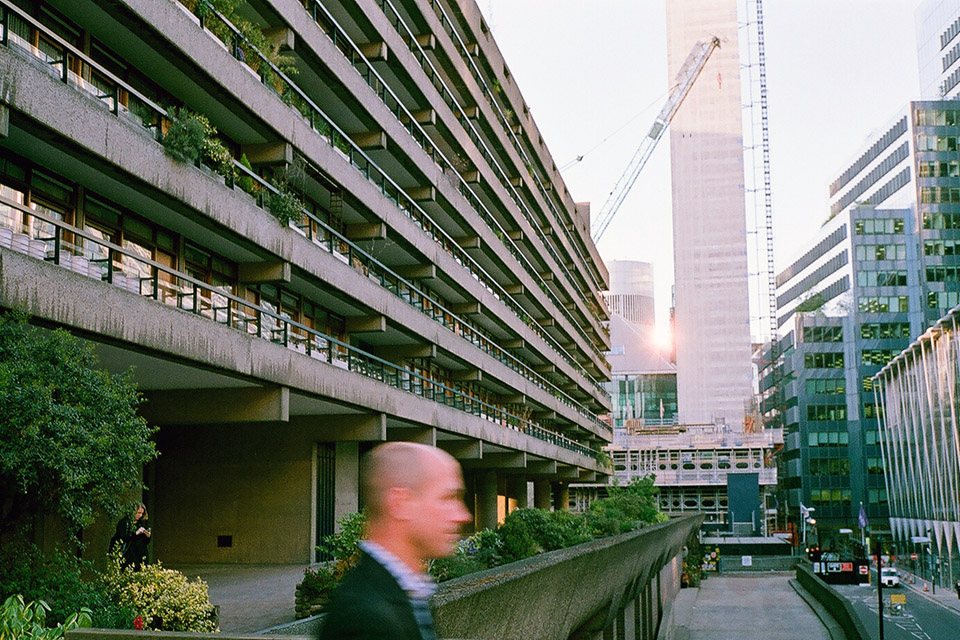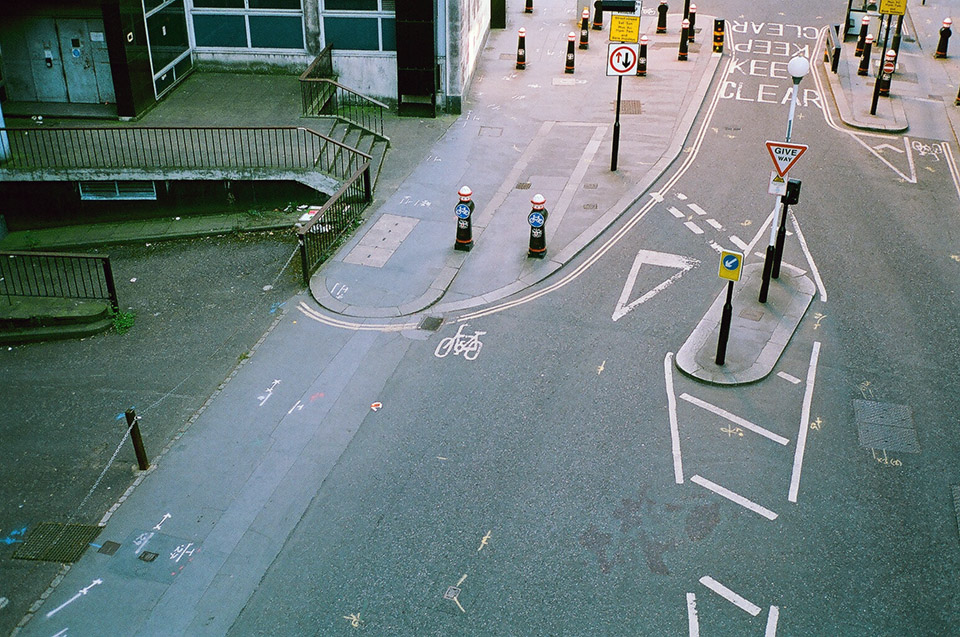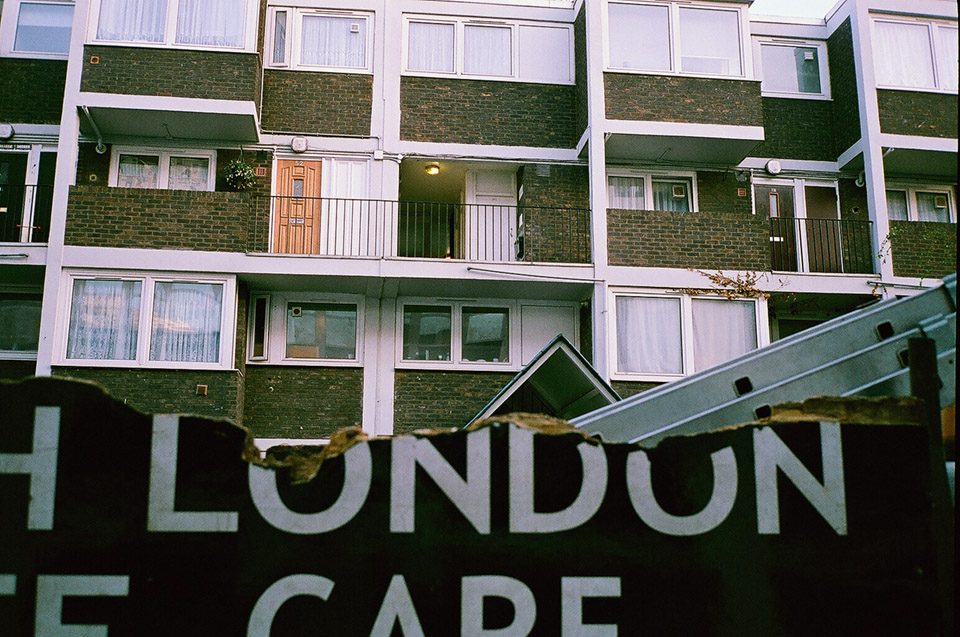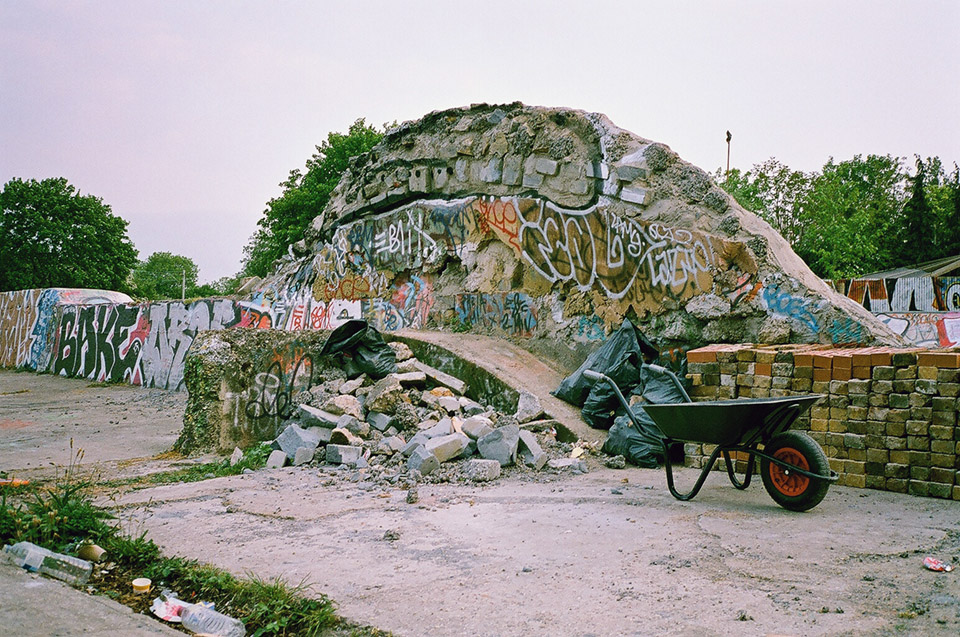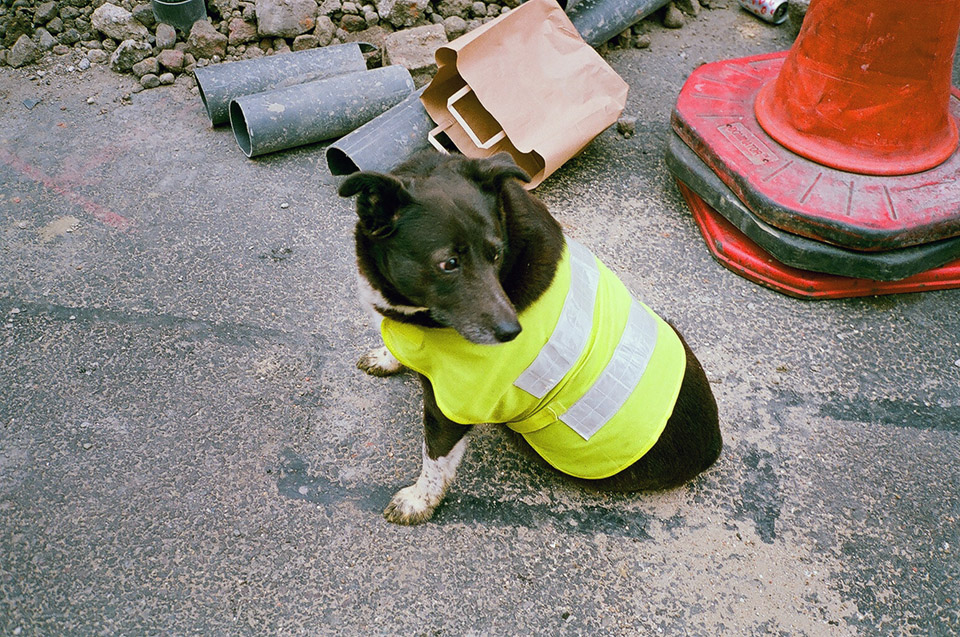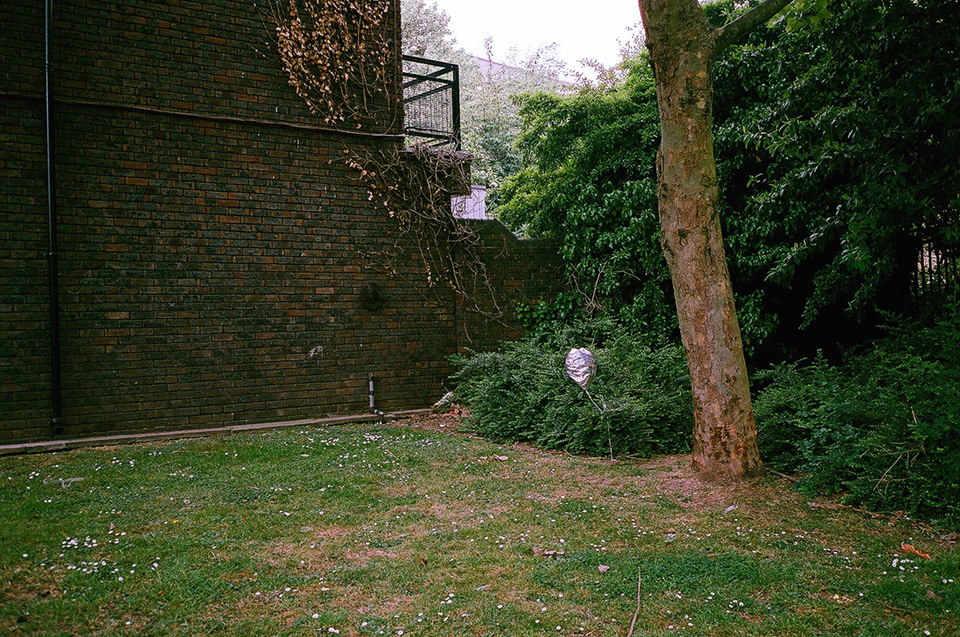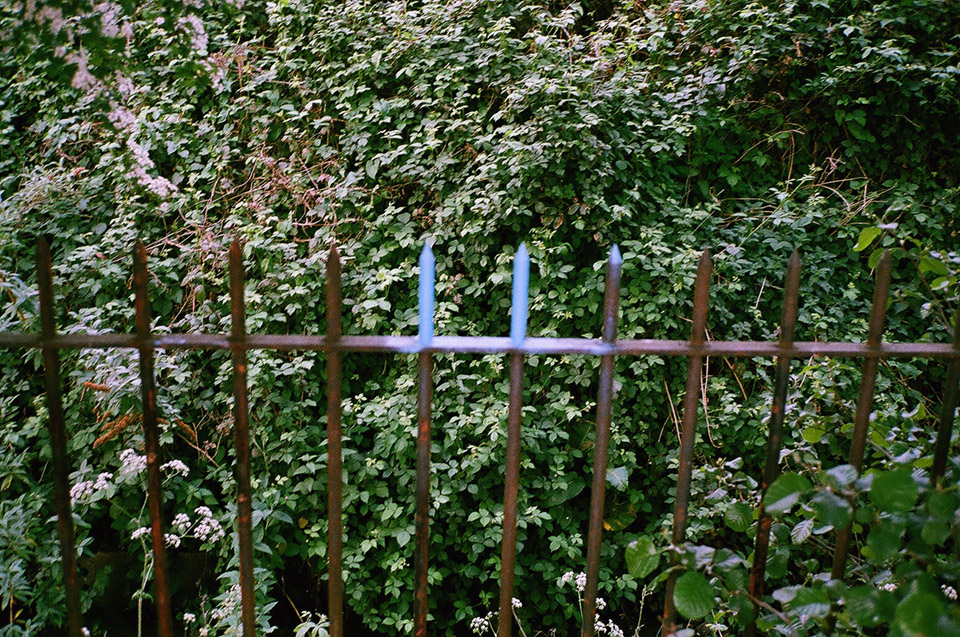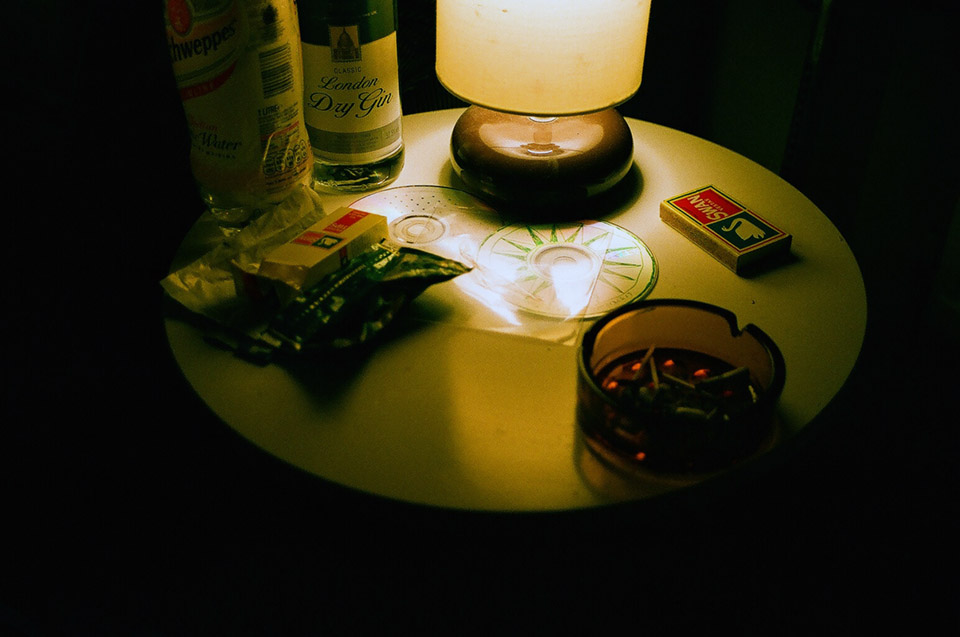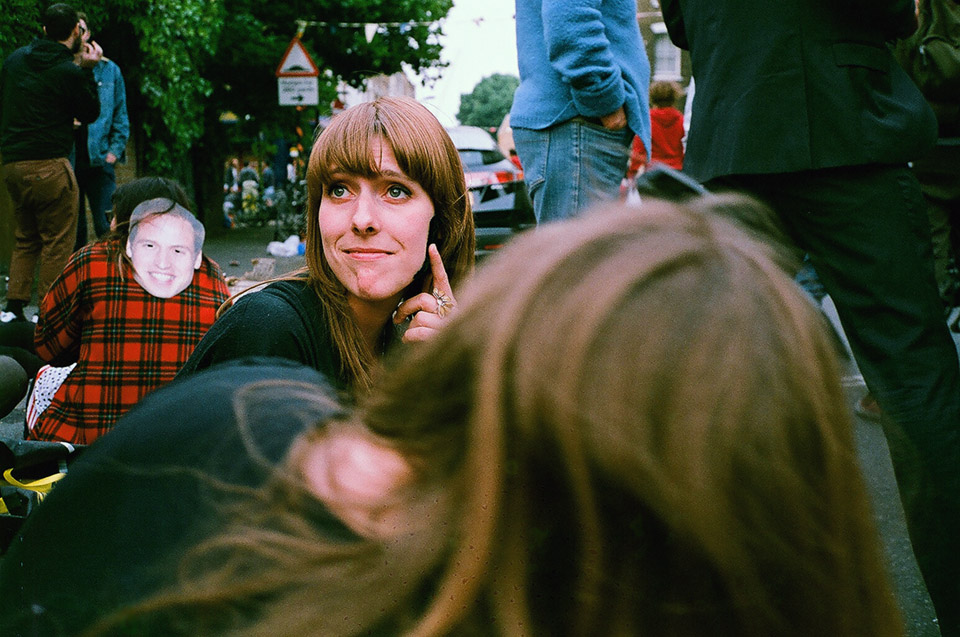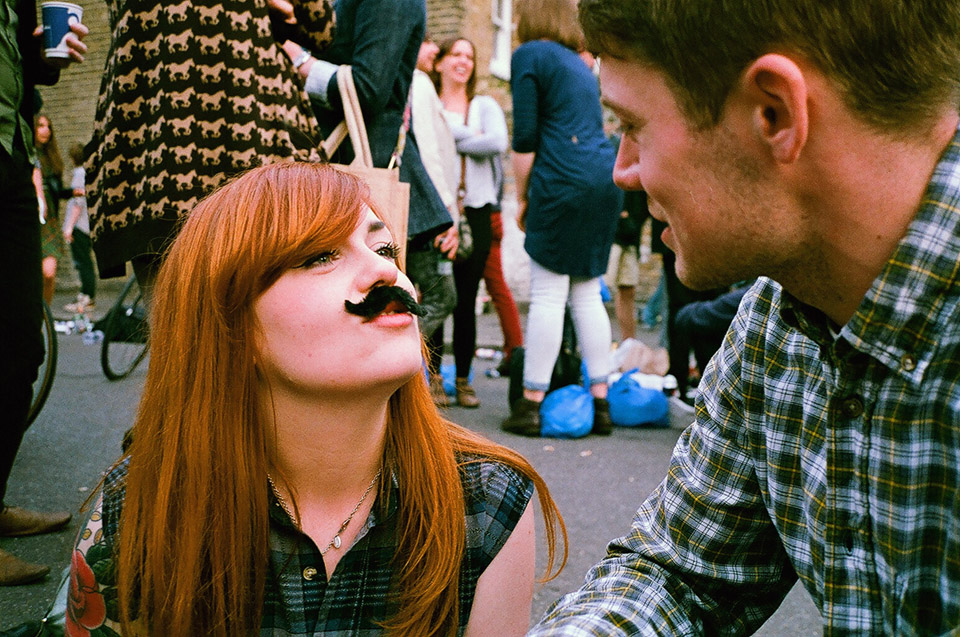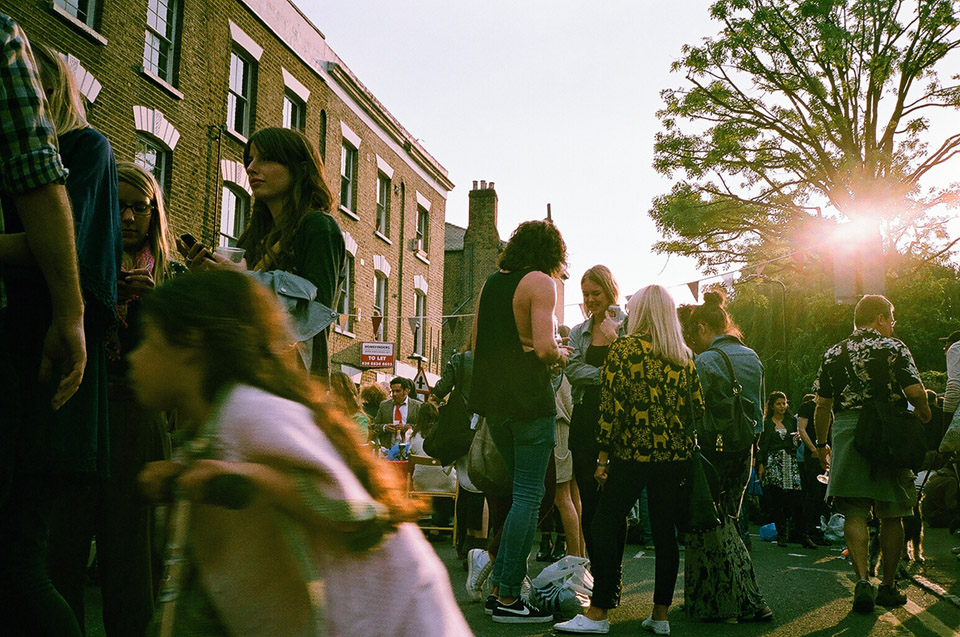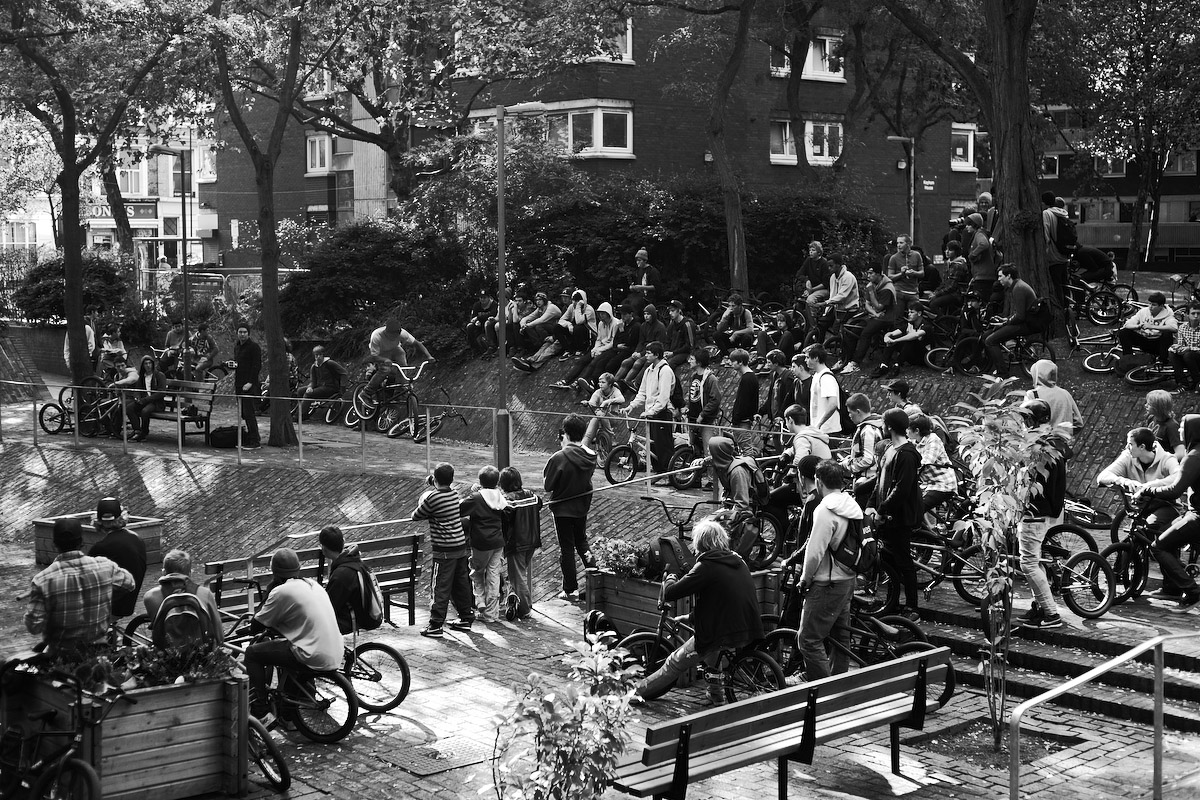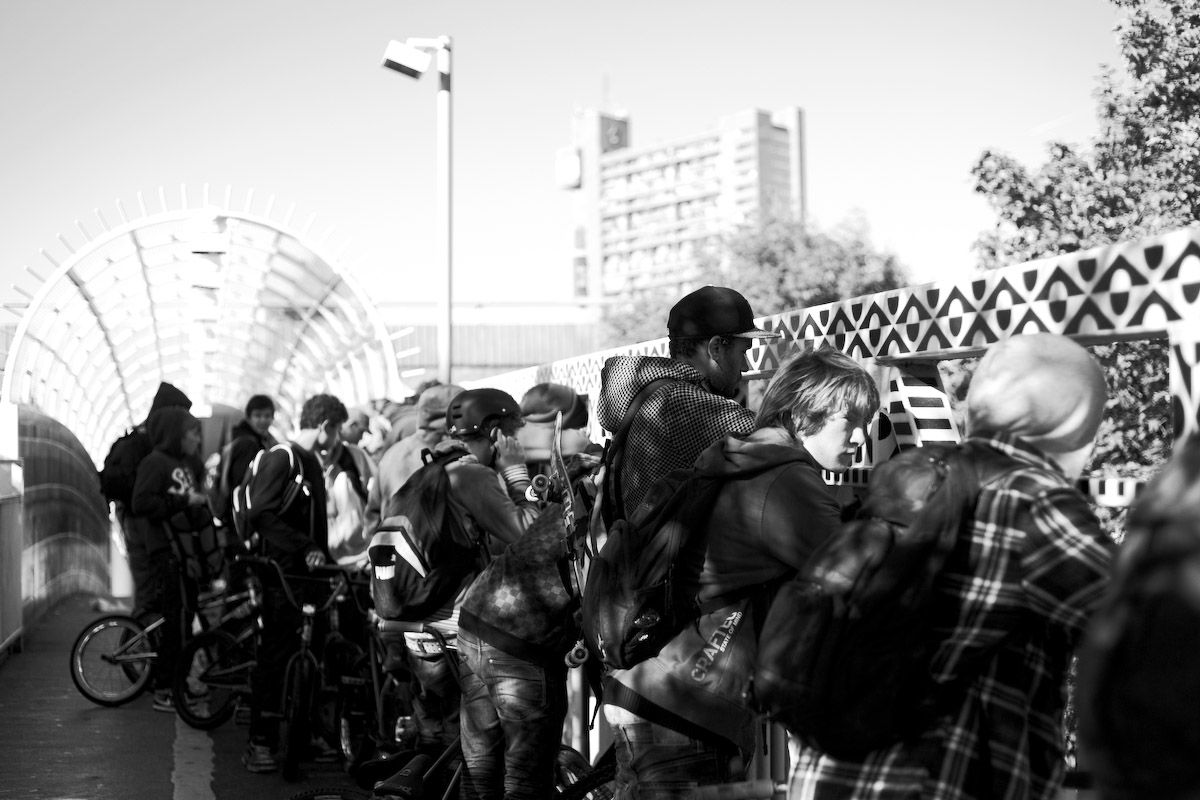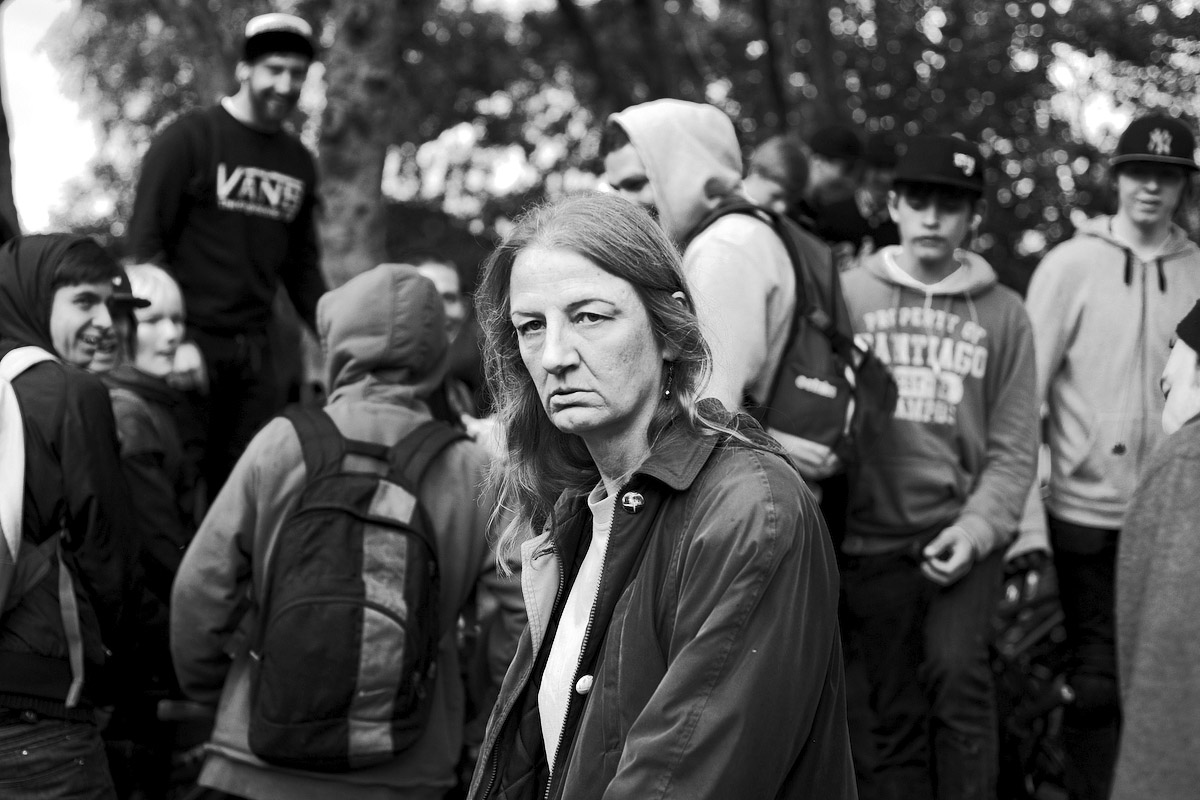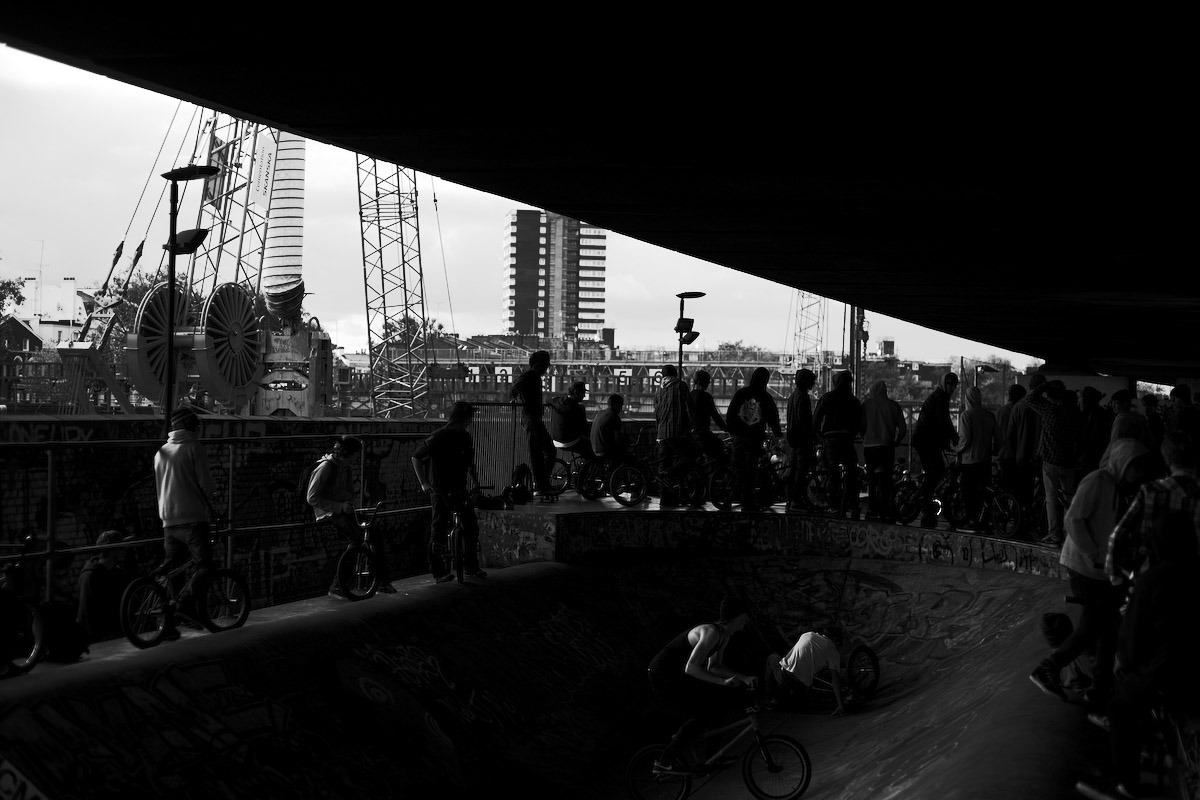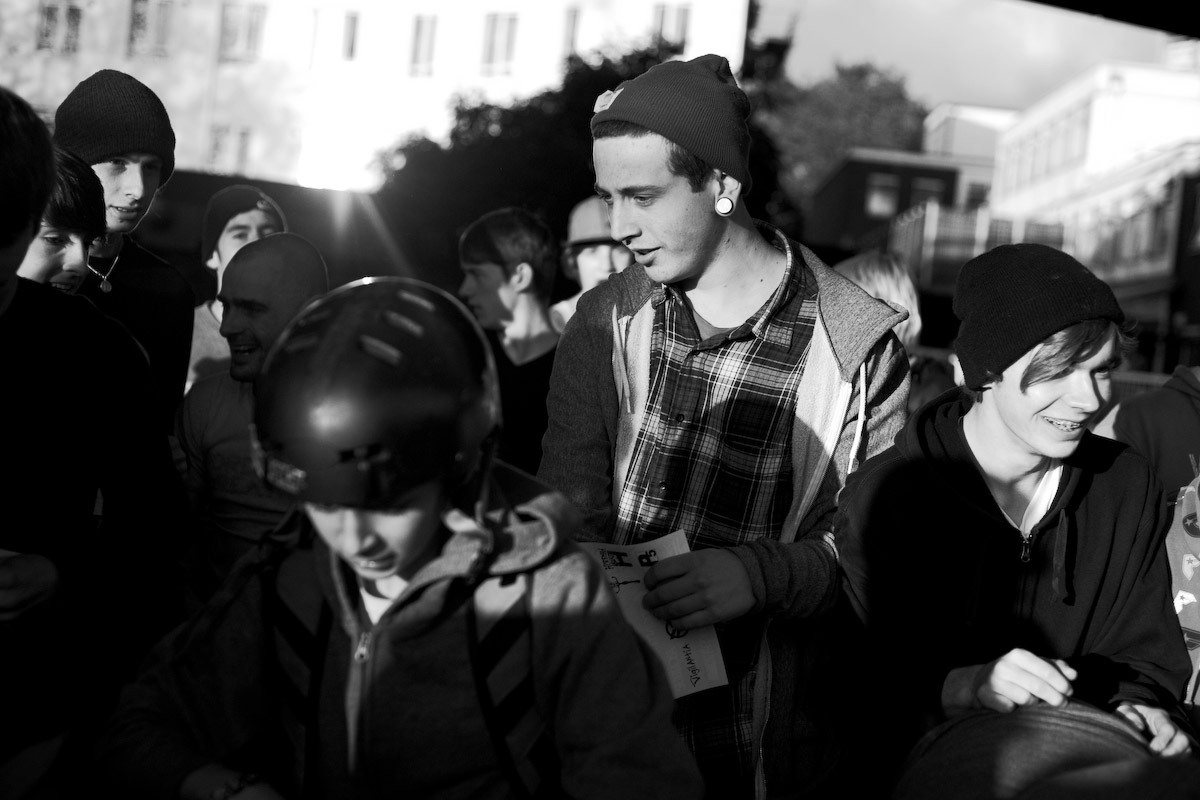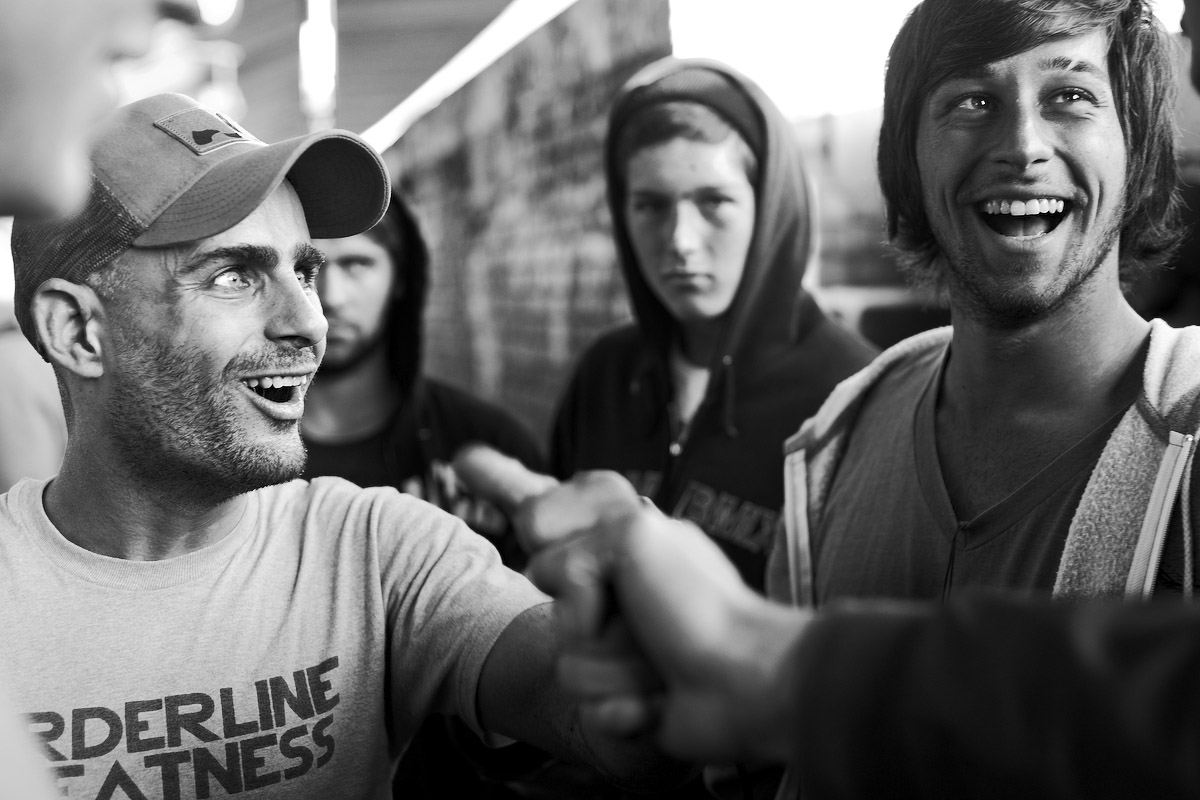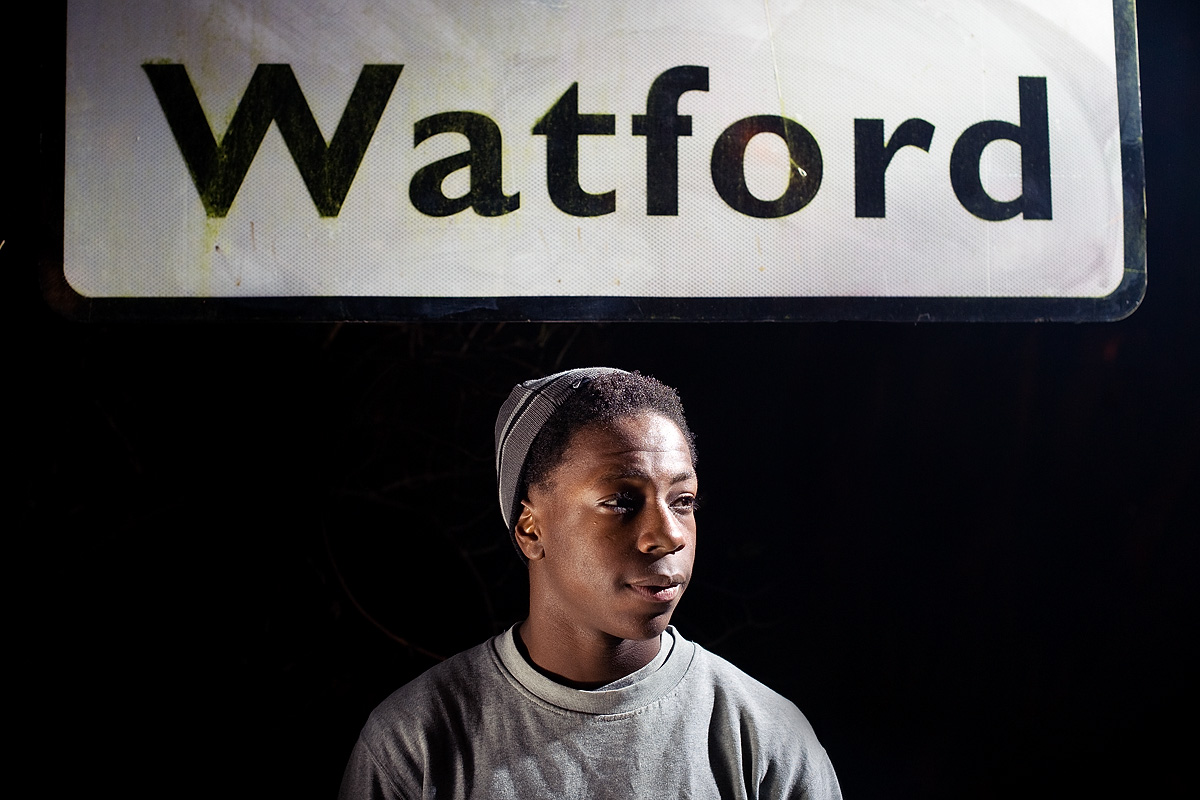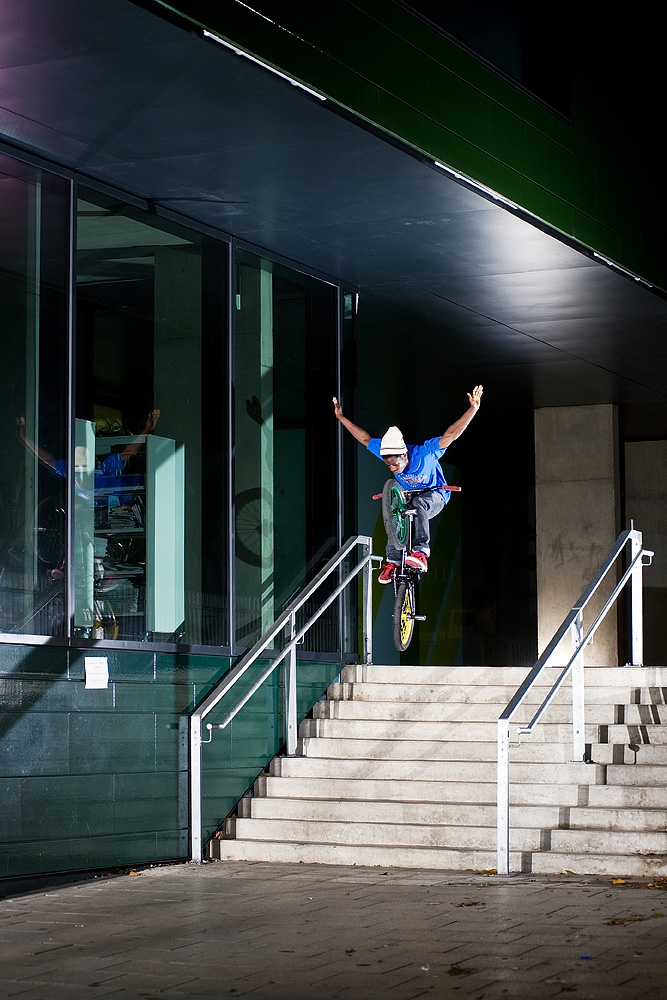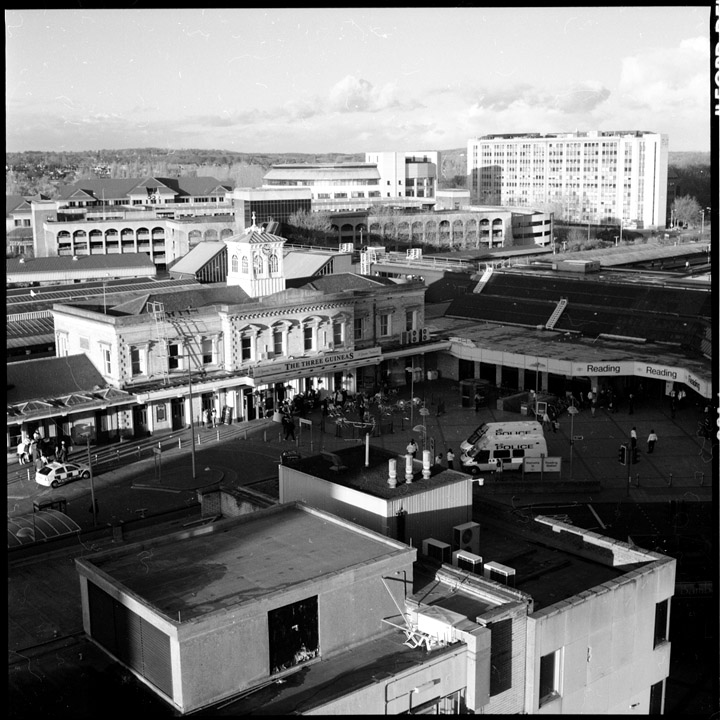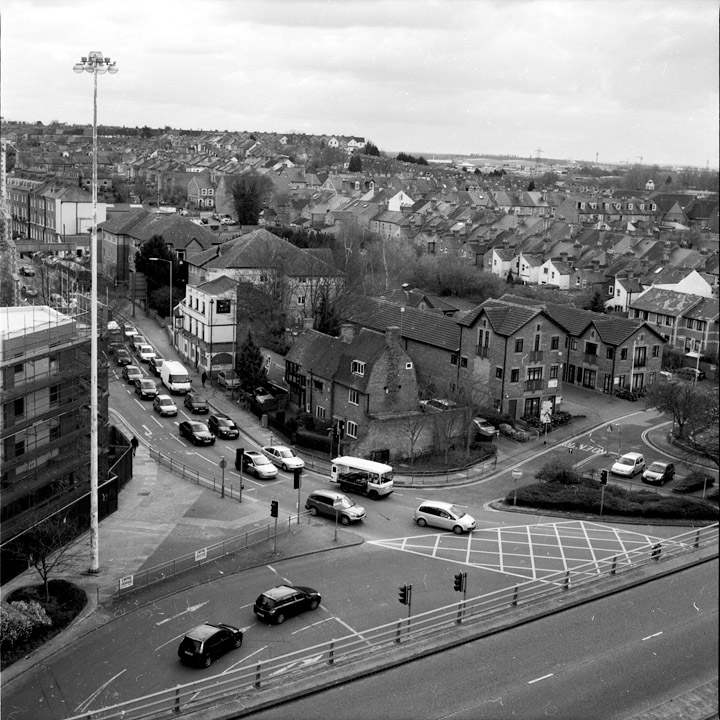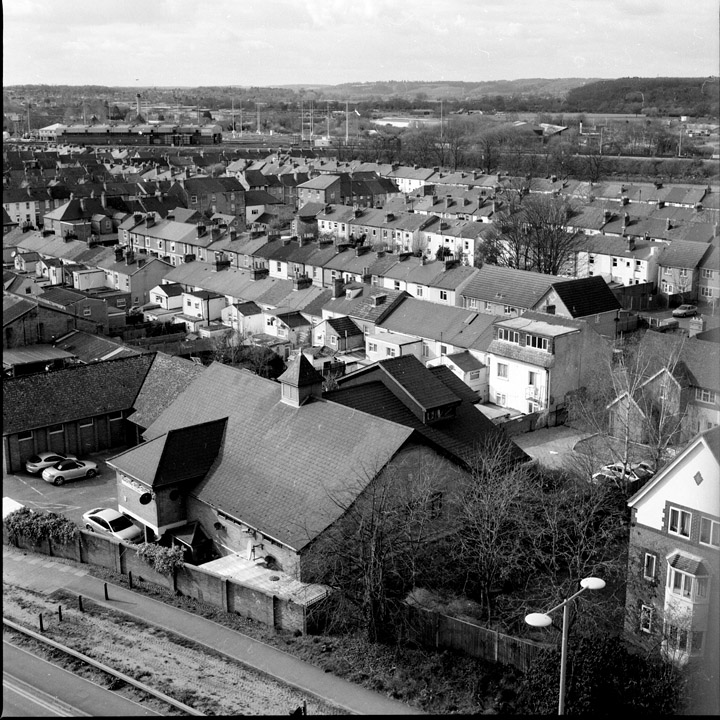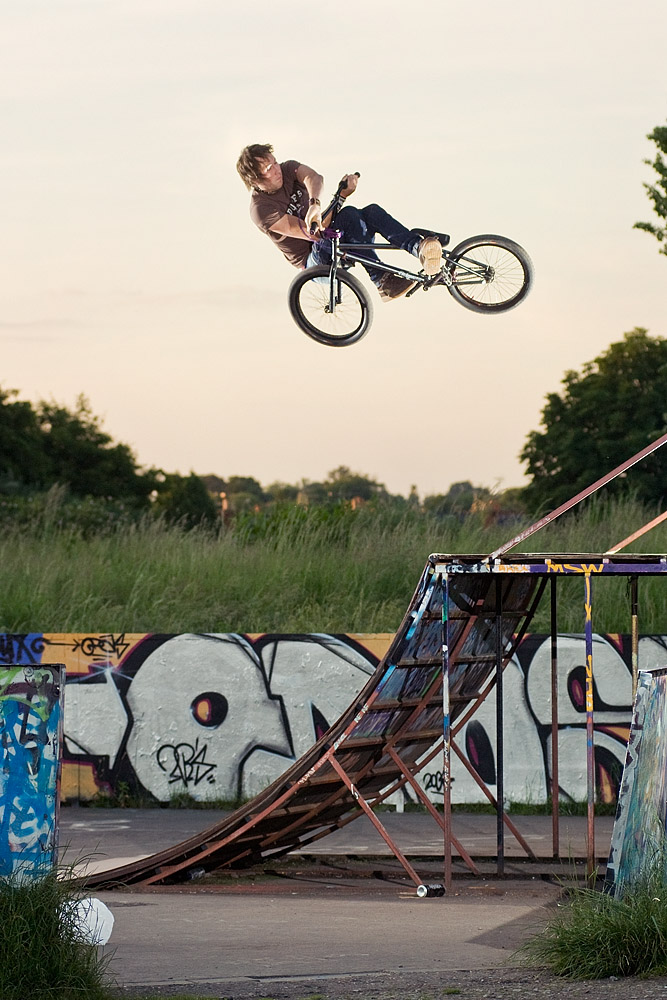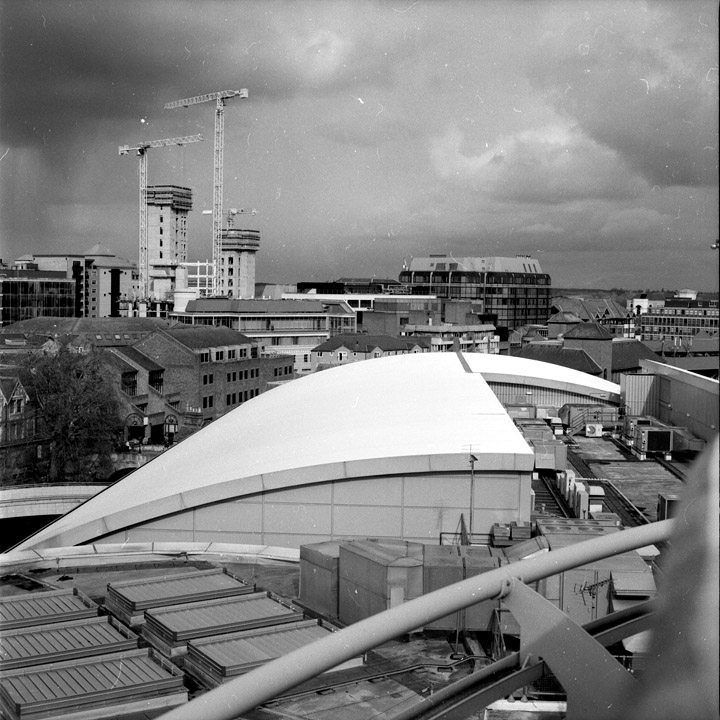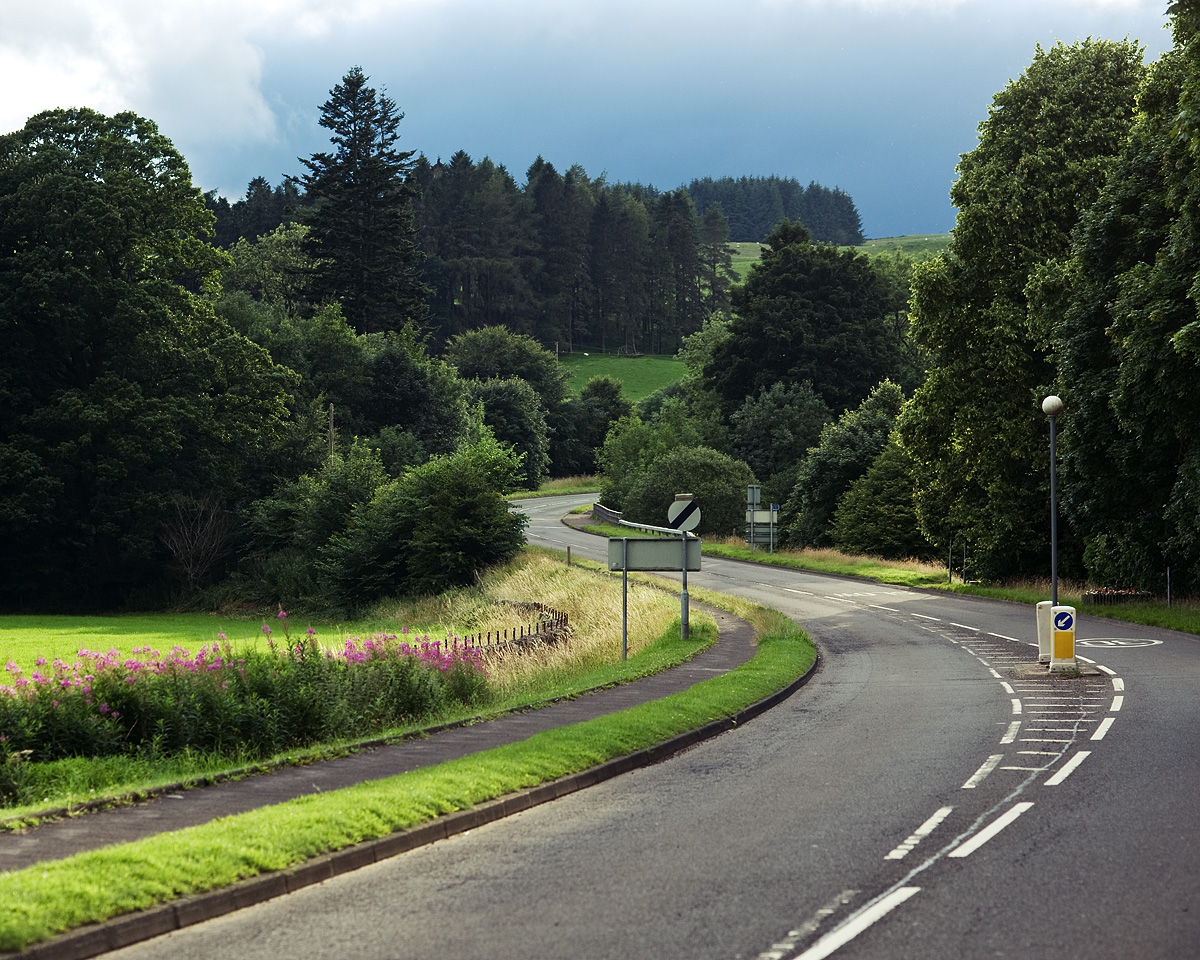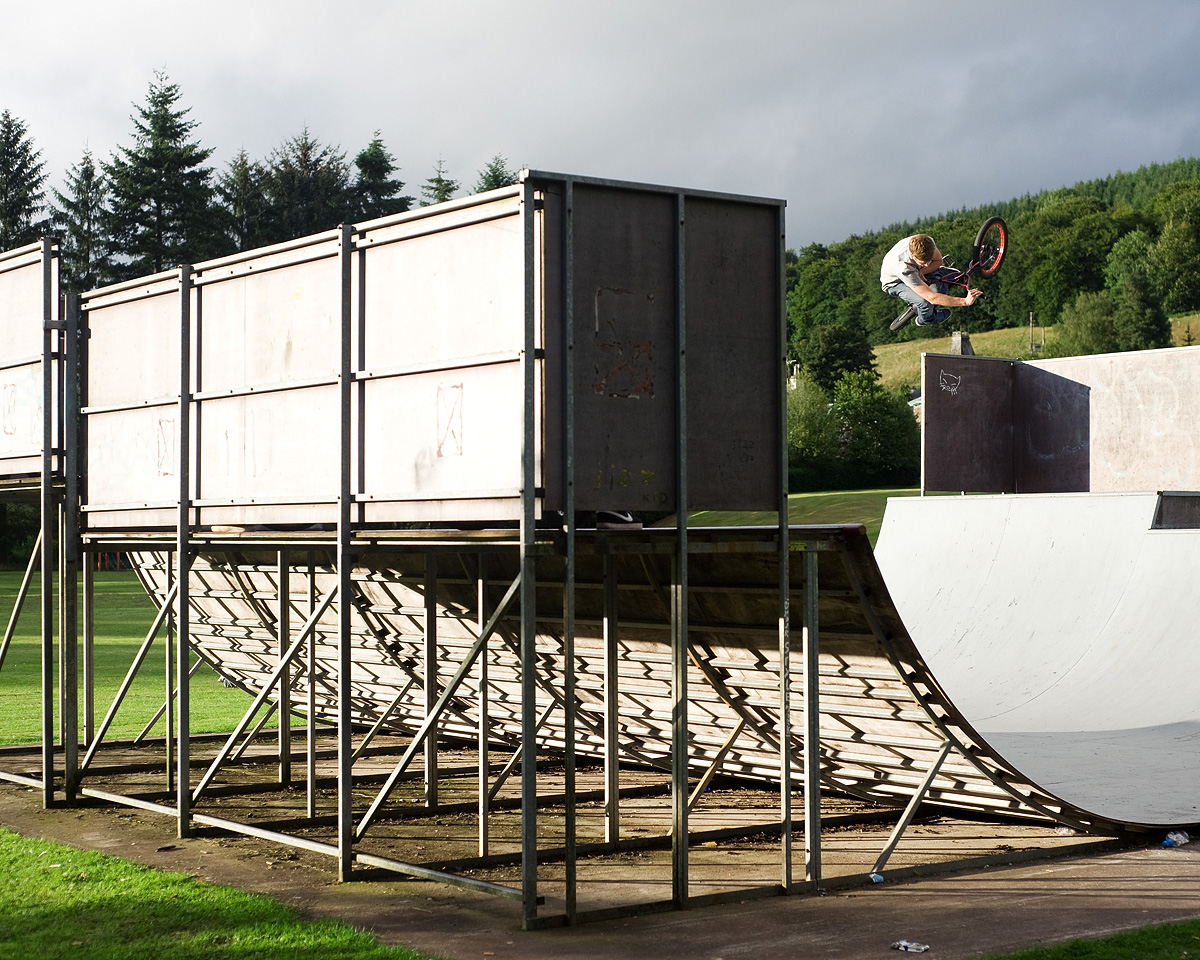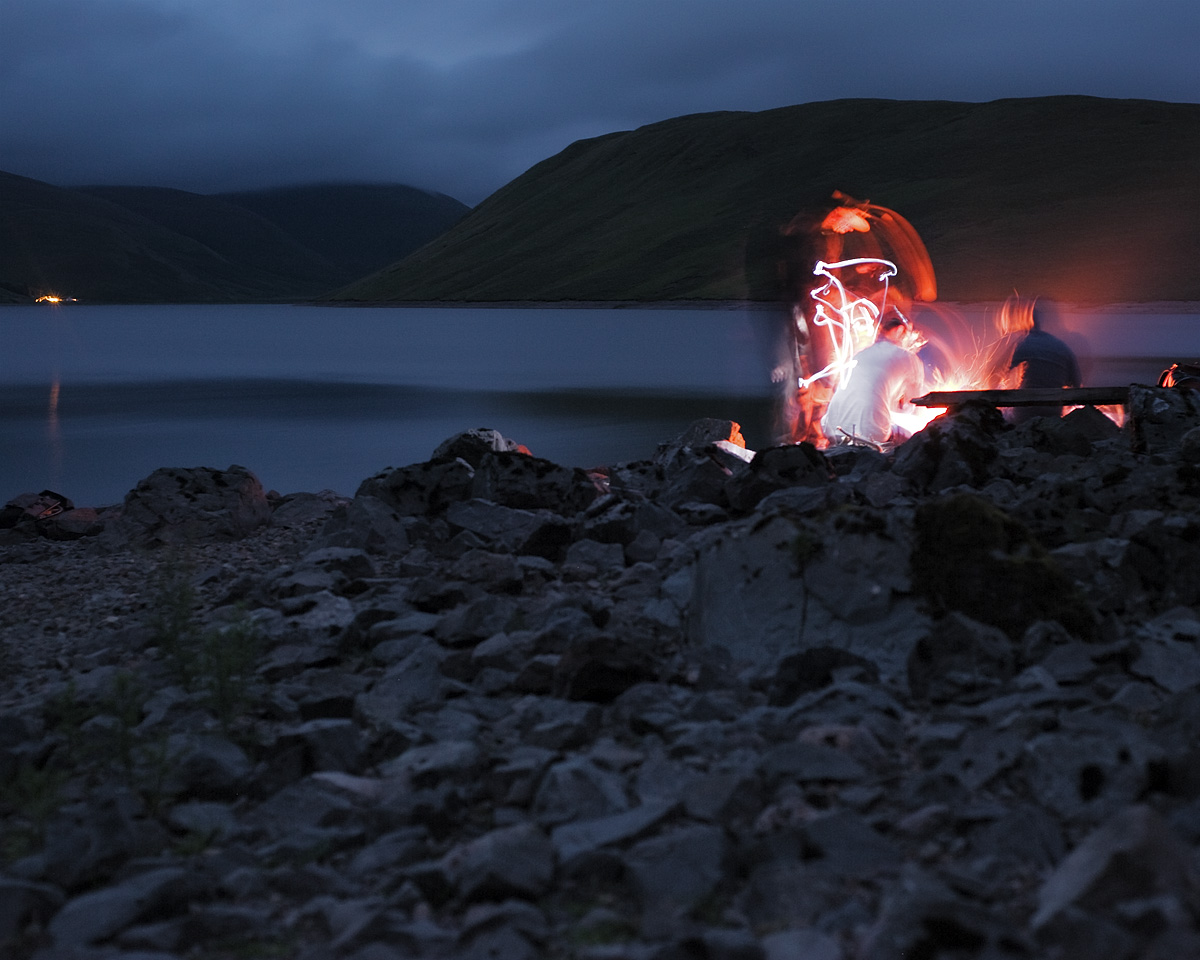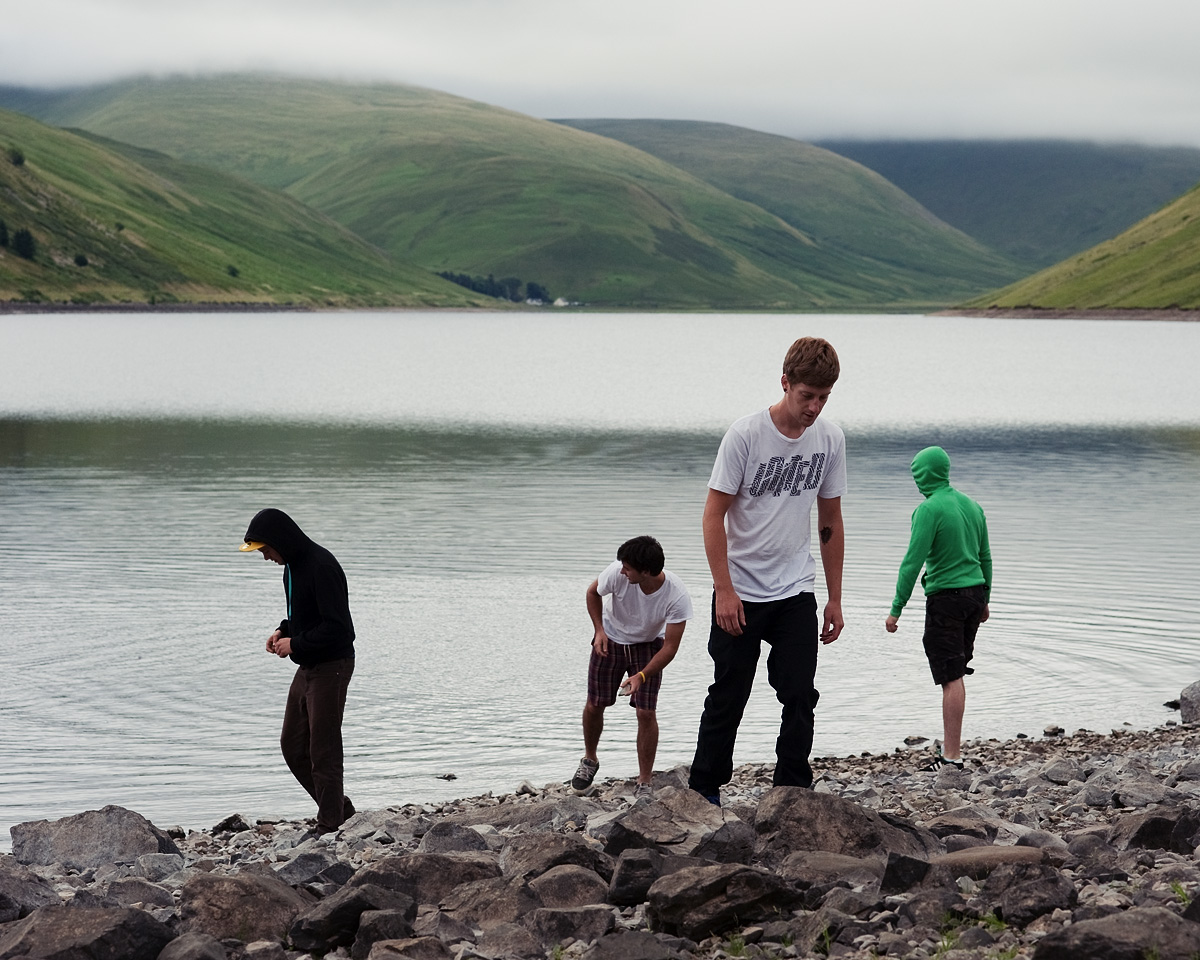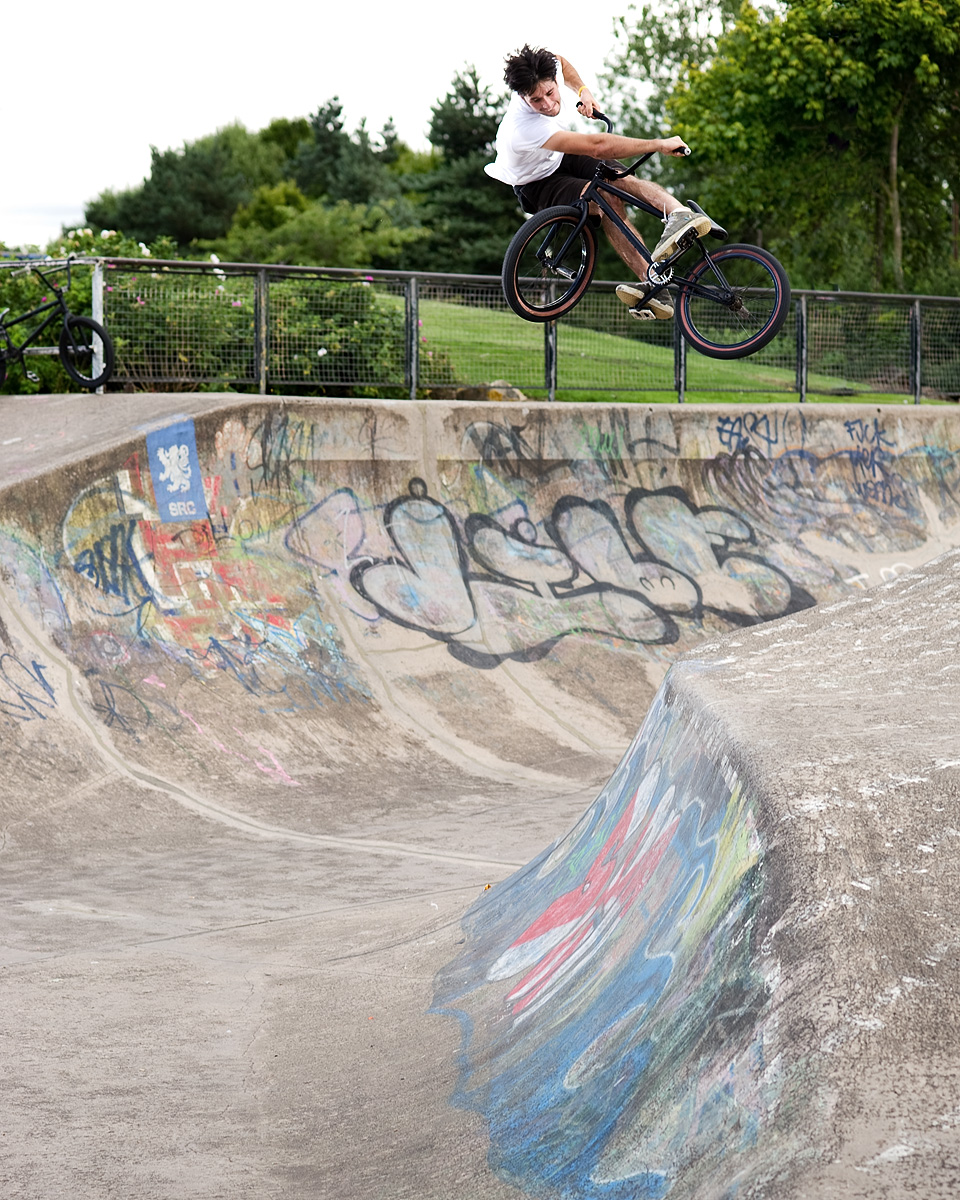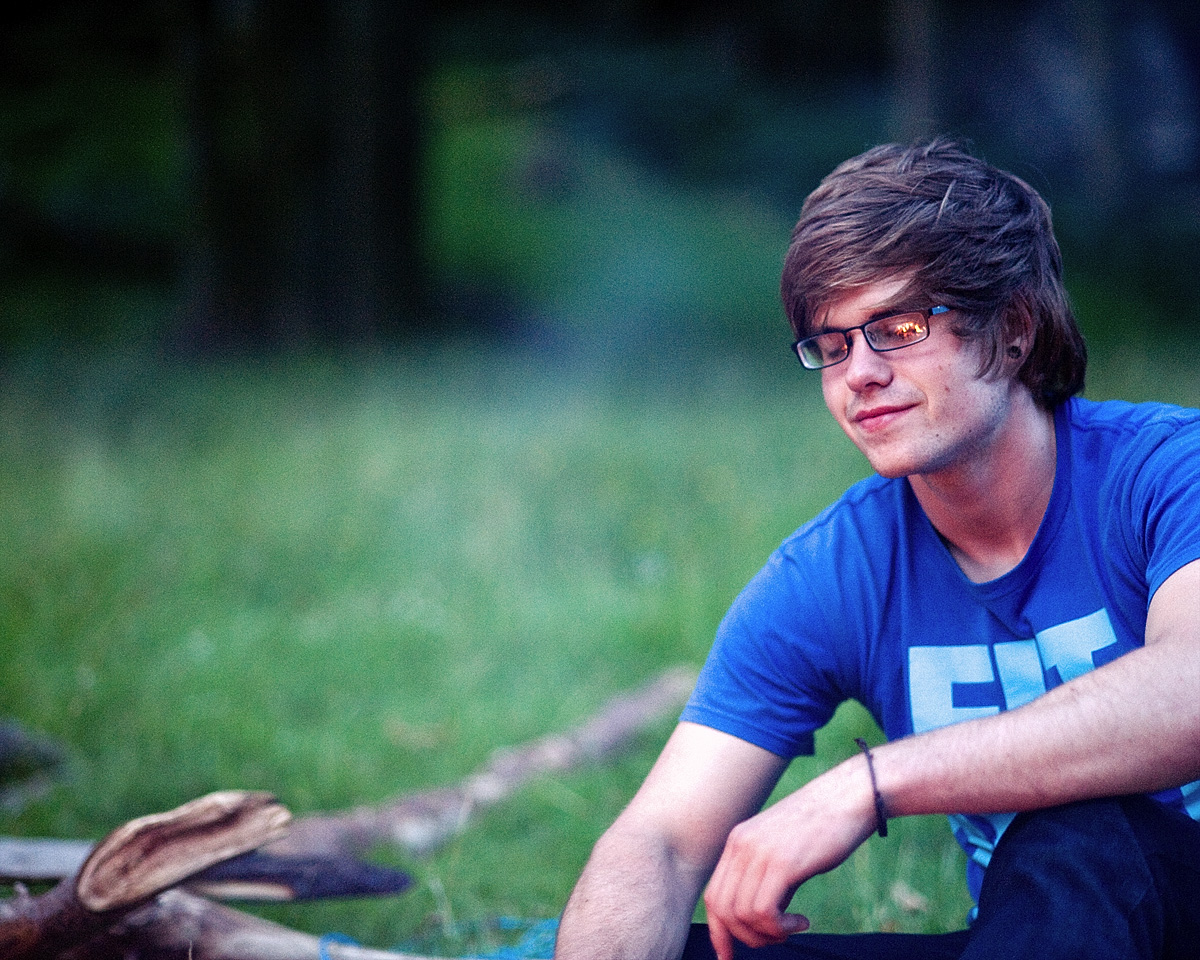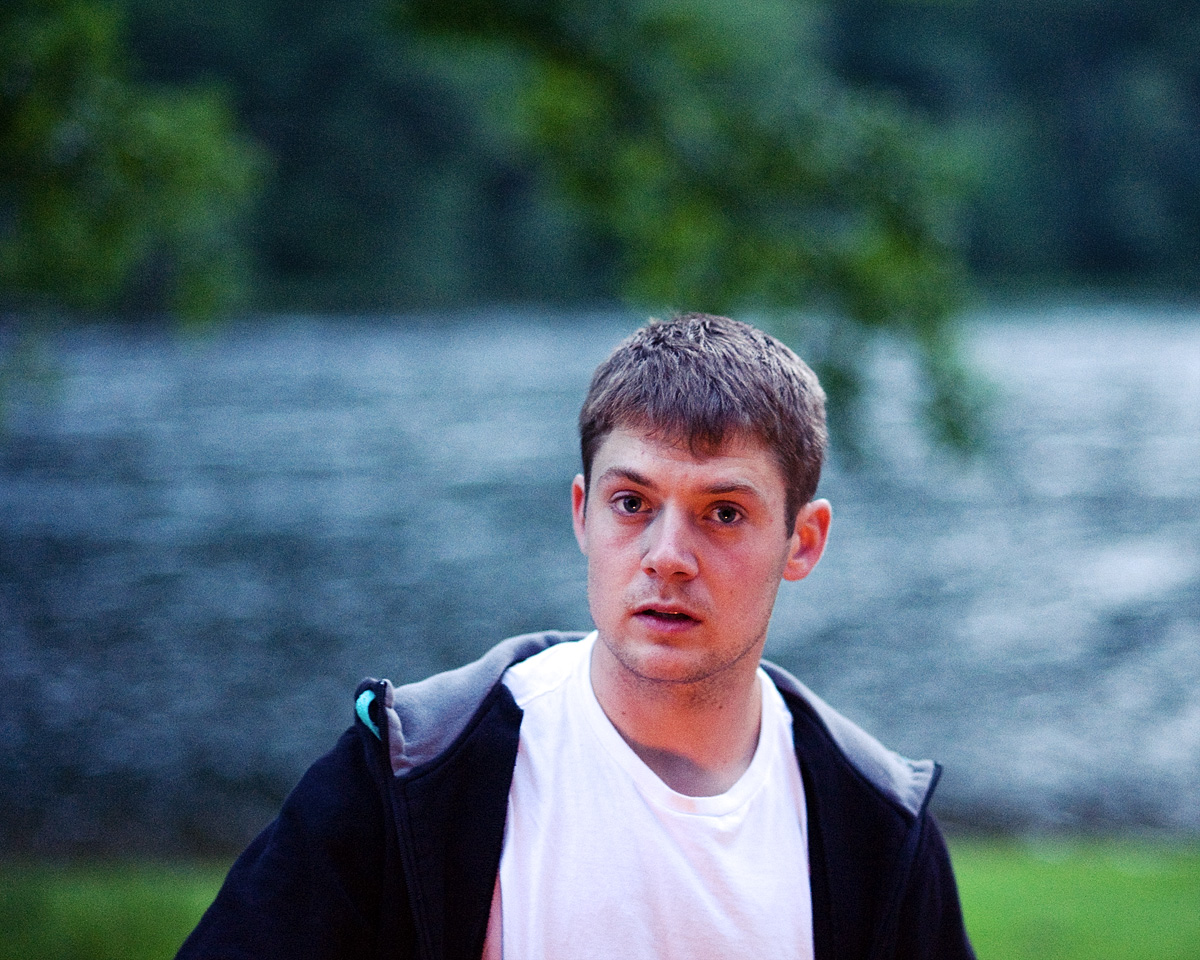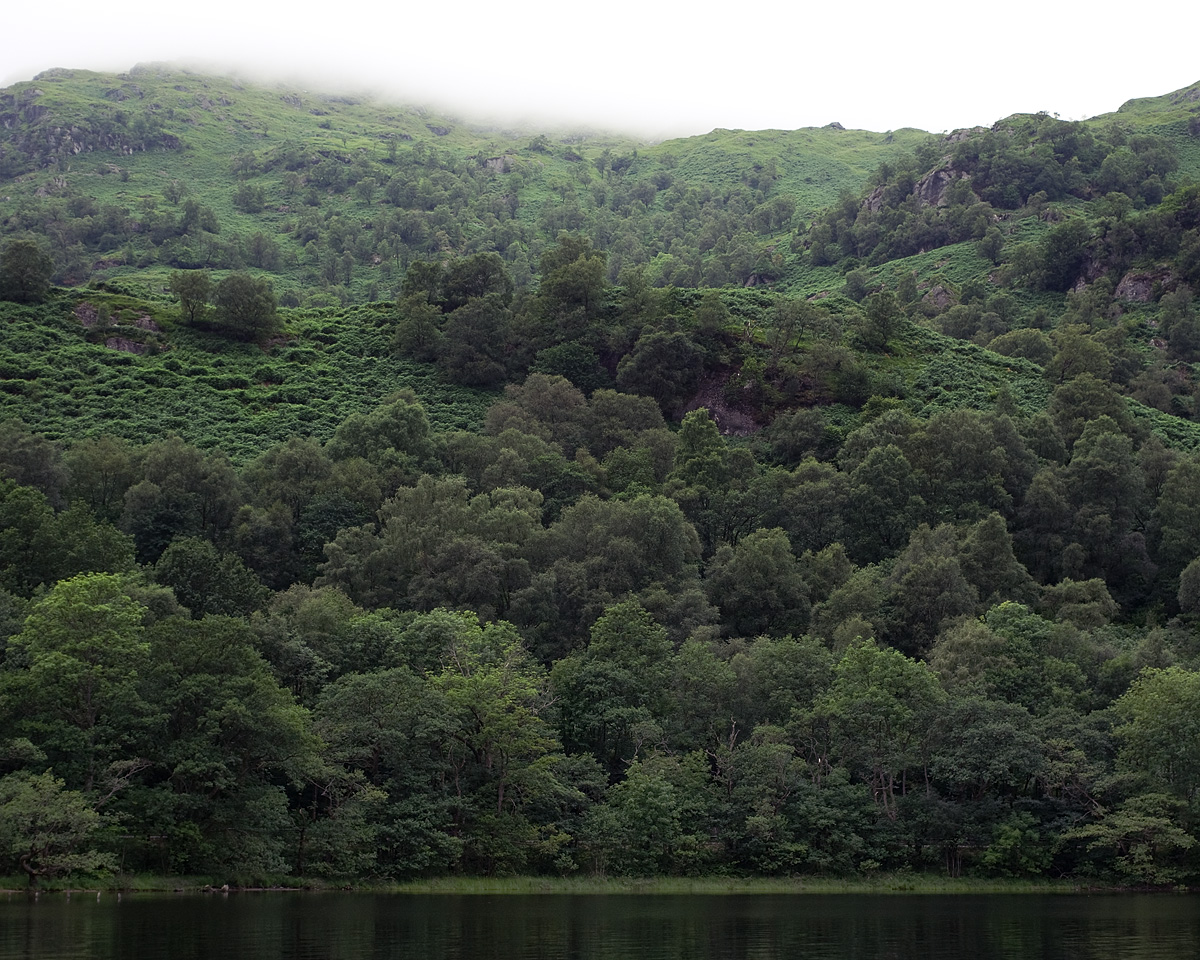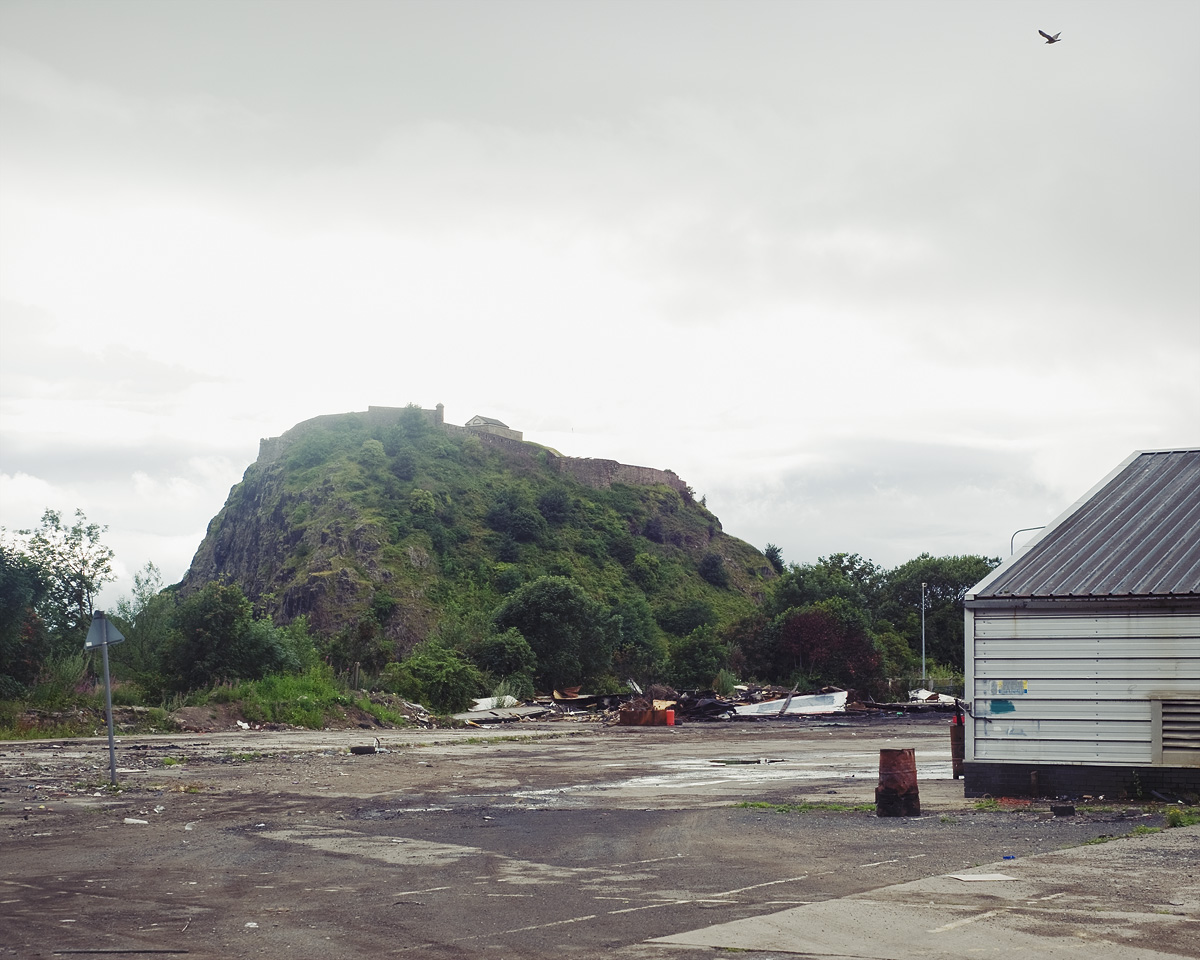Last week, in the long search for a camera that’s smaller than my D700, I ended up buying a Contax T2. The following is a selection from the first test roll I put through it. If you’ll forgive the gear talk for a moment, it seems like manufacturers are missing a massive opportunity in a big-sensor digital camera that operates as effortlessly as the T2 does.
—
Originally published in Ride UK issue 146, November 2010. Appears here in a slightly edited form.
I raised my eyes briefly. A hundred metres ahead the road rose, mirroring the descent I was making. A further hundred metres away I could see the head of the pack. With my eyes I followed the mass of riders back up to my own position, past the pubs on the corners and the cameraphone-wielding patrons outside them, past the 4×4s driven to the kerb, nearside indicators firing nervously. The road was filled with BMXers, tightly but evenly spaced, like strangers in a crowded lift. It was impossible to tell over my shoulder how far this carried on behind, but it ended with a police car or two, everyone knew that.
…moving in the same direction was more important than moving in any geographic direction
We were somewhere in Notting Hill, North West London. With no indication of where we were going—the route had been abandoned—moving in the same direction was more important than moving in any geographic direction. Staying in motion together meant a sense of invulnerability, just as staying stationery together in the courtyard of some council estate had meant invulnerability from whoever might lurk there, or so we thought. Sheer numbers are the draw of these street jams (which is strangely self-fulfilling: lots of people turn up because they know that lots of people will be there). Estimating the exact number is difficult; I heard 150, I heard 500. If you haven’t been to a similar event then it’s guaranteed to be the most BMXs you’ve ever seen ridden simultaneously.
Another draw of these jams is their egalitarian nature. More formal contests put barriers between the riders and the spectators. At a jam like this the riders and the spectators are one and the same, like a swarm of identical bees working as a single super-organism. Each bee follows its elegantly evolved self-interest, and in doing so maintains the order that sustains it. The jam made do with one stickered megaphone and a spot list scrawled on a sheet of A4. Order wasn’t to prevail.
It took a lady in a drab raincoat on an estate near Latimer Road to trigger anarchy in the group. Everything—clothes, hair, pallid face—seemed to hang from her. Dark eyes were her only fixed feature. Looking into them you could see that she was singularly crazier than we were cumulatively. At the first spot on the estate she parted the group, shouting at no-one in particular, on her way to wherever she was going. At the second spot on the estate she returned doubly riled. She kicked and shoved a bewildered kid back into those around him. I’d guess that he was sixteen and unsure how to fight a woman of pensionable age, let alone what the moral implications of doing so were. She turned and walked away from the rising jeers, only to turn back and start again on someone at the edge of the throng. It was an awkward dance, her desperately trying to engage someone in proof that we were a group of vicious thugs, the group throwing nothing worse than half the contents of a beer can and some bizarre insults.
The estate had gone from eerily empty to an eerie sense of being watched. From behind the surrounding windows, emerald-green like deep water, it wouldn’t have looked good. I suspect that the other residents had something to do with the police turning up as we were leaving.
“Chase” might be a generous word for the ensuing tour of Notting Hill backstreets; no way could so many people on bikes escape a police car, not by outrunning it nor by outmanoeuvring it. Each time flashing blue lights appeared over the heads of those in front everyone would swoop, barend-to-barend, into another street. It only seemed to postpone the eventual arrest of whoever got separated. Yet after a quarter of an hour they gave up, so those at the back reported. I like to think that they were baffled, that what we’d just participated in was so outside the realm of usual city existence that even the police didn’t know how to manage or contain it.
The jam ended back where it had started, Meanwhile II skatepark, under the A40 flyover. Prizes were handed and tossed out, the reminiscing about the day’s events began. What rough plan there was hadn’t come to fruition, but it didn’t matter. Madness flourished between the cracks in the order of things and in each other—and in each other we found validation. It’s OK to be crazy if you’re not the only one.
—
Originally published in Ride UK BMX Magazine issue 136, January 2010. Based on a interview recorded in November 2009. Appears here in a slightly edited form.
Queen’s Park, Kensal Green, Willesden Junction, Wembley Central and on to Watford is 31 minutes on a stopping train. The distance is not, physically, great. But in a city like London, sliced up along arbitrary boundaries, it’s an inter-planetary, incomprehensible distance. Here, where you live is inextricably linked to who you are. It’s one of the first questions the newly-introduced ask each other, and identity is implicit in the answer. Akin Hercules-Walker’s parents were concerned that the sociological implications of these boundaries would lead him to make, as he puts it, “some bad decisions”—from drugs, to robbing people for money for drugs, to carrying weapons in the belief that they will protect you from being robbed for money for drugs, or just for your phone.

Watford to fakie
Akin Hercules-Walker turndown Watford
Unused photo from Akin's informer in Ride UK issue 136, out now.
I was conditioning myself to not really careSo it was at 13 that Akin moved, with his family, to Watford, a suburban enclave between the definition of outer London and its orbital motorway, the M25. W9 to WD19 in postcode parlance. BMX is something he took to Watford with him, having been going to skateparks in London for about a year. In other words, he’s now fifteen, has been riding just two and a half years (a short enough time to still count the half-years) and possesses the abilities of someone who’s been riding considerably longer.
I don’t press him about exactly how deeply involved in violence he became, if at all, but it wasn’t something he wanted to become involved with. “I’ve always been the sort of person that, when I was with my friends, I’d try to stay away from the people that were robbing. But you can never really stay away for that long if you know people like that.”
London has always had violent parts, though which exactly they are varies. Often they abut, or even become some of the most desirable parts. The youngest child by some margin, Akin was perhaps unlucky to have been born into an area that was and is one of the more violent. Kidulthood was set in the same part of London—to the extent that Akin had three friends living in the same tower block where the character Sam lived. His parents have between them successfully brought up five other children (three brothers and two sisters), some of whom (two brothers, one sister) are in their late twenties, settling down and starting families of their own. I never got to properly meet his dad, but his mum is a professional, educated person who refers to Akin as her “baby”. She is a positive, loving influence, perhaps attributable to the Rastafarian faith she shares with her husband. Akin doesn’t consider himself religious, but is influenced by the peaceful and respectful aspects of his parent’s faith. Not that he doesn’t enjoy boisterously flirting with any girl in the immediate vicinity, or getting higher than he previously thought possible at a good house party. But he is certainly all too glad that, at 15, he is not a street-level coke dealer like one former peer he mentions. So while he doesn’t contest that it’s possible to grow up where he did and still “actually do something with your life”, it was more that he was losing sight of that alternative: “I was slowly getting more used to doing the sort of things they were doing, I was conditioning myself to not really care.”
Akin “rode around on BMX bikes” most of his life without considering himself a BMXer. In the last year of being in London he saw Animal’s Can I Eat and out of curiosity started going to the skateparks local to him: Meanwhile 1 (old-school concrete bowls), Meanwhile 2 (old-school concrete flatbank half pipe), and, further along down under the A40 flyover, Bay66 (wooden, formerly named Playstation, often used as a filming location for “urban” video shoots). Plenty of places to ride, though he says he didn’t take it that seriously, only riding weekly or thereabouts.
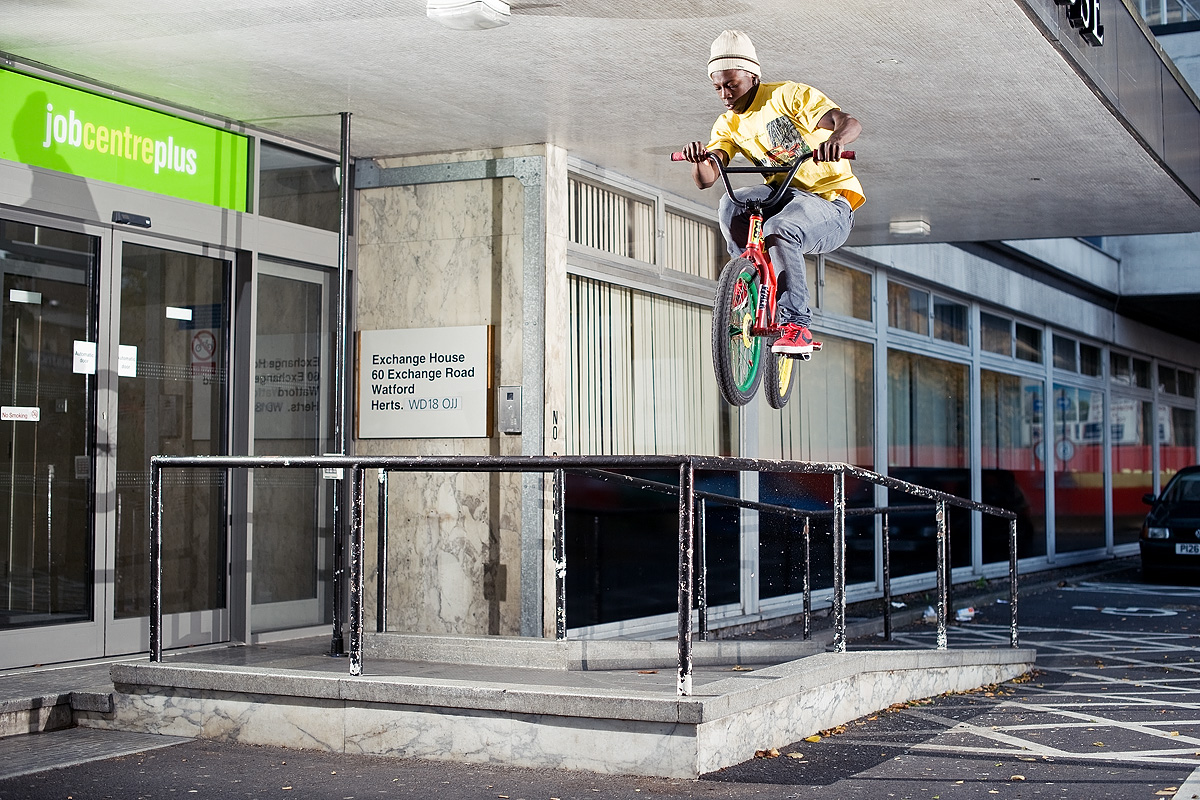
Job Centre
Akin Hercules-Walker double peg Watford
Double peg up to hop over the corner. Published in Ride UK issue 136.
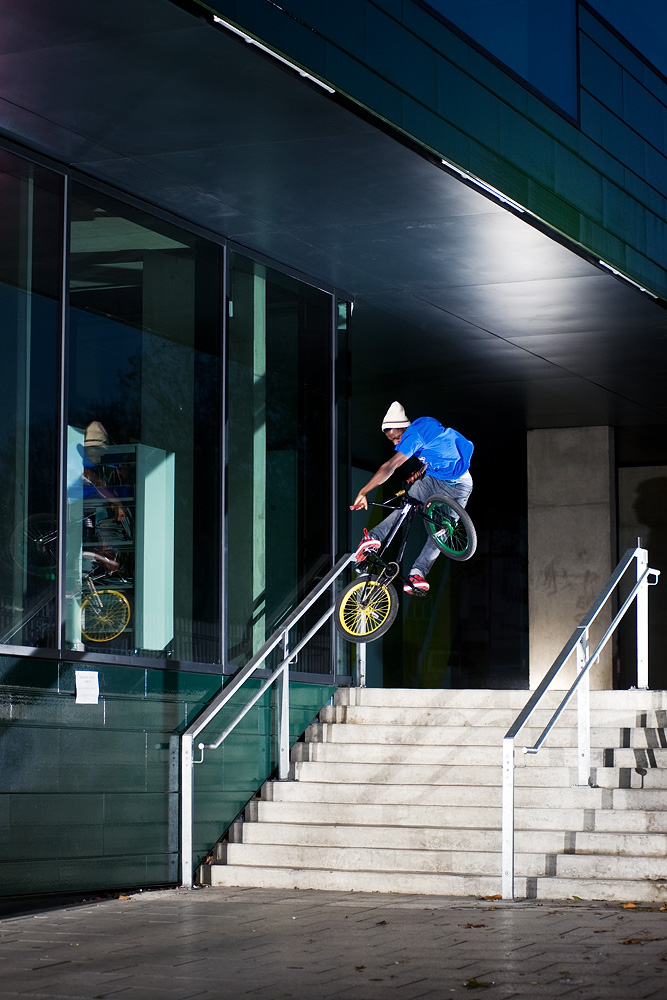
Harrow Road 2
Akin Hercules-Walker turndown London
This was a warm up for the no hander that Akin did here. Never bothered submitting this because I thought we already had a better turndown photo.
…you don’t have to stop everything else in your life to rideWatford is a safer place: there’s the odd lairy high street drunk, semi-detached bedroom weed dealer, and bean can exhaust scraping the speed bumps. Compared to London, there is less than half the amount of violent crime, and an eighth of the amount of robbery. When I ask what he misses about London Akin says “just calling someone up and going and sitting somewhere”. A succinct explanation of the difference—in London you can be passive and there’s always something interesting happening around you, in Watford you have to be proactive—and an explanation for why he started riding more often.
He also found that in Watford riding was a more acceptable thing to do. There’s a greater variety of people that do it, “I realised that you don’t have to stop everything else in your life to ride”. It was in Watford that he graduated from being the kid with a BMX bike who’d go to the skatepark, to what he considers a BMXer, to the kind of person who can’t really imagine what their life would be like if they weren’t a BMXer, “Even if I didn’t ride I’d still hang out at the skatepark and talk to the same people I do now”. His riding is still primitive—self-describedly sketchy but in the best, most gut-level-exciting way. His friend Dom says that “he rarely thinks before he tries things, but they usually turn out pretty well.” Akin says that “I’m usually pretty surprised when I want to do something and I don’t … If you hurt yourself doing something it seems pointless to stop there—you’ve hurt yourself for nothing.” There’s definitely the beginnings of a style to his riding though; he has the power and simplicity that separates interesting riders from huckers and nibblers.
He cites a real mixture of influences from Etnies’ Forward (made three years before he started riding) to recent Volume web edits. In terms of riders, it’s mostly contemporary street guys like Randy Taylor, Nigel Sylvester and Corey Martinez; as well as the Watford locals he now rides with (Jason, Dom), and former area local Lloyd Wright. His bike is a rattling approximation of a modern-day street bike (brakeless, wide bars, two pegs, visible seat post, freecoaster) held together with zip ties used for things that zip ties really shouldn’t be used for. When I first met him at the Dub/Carhartt/Project 5 London Jam, it was nearly all red. Shortly after, we began shooting the photos for this article and it had turned the green, yellow and red of the Ethiopian flag. By the time we were getting the last couple of photos done it had gone all-black (but still with a green front wheel and yellow rear wheel). He estimates that there are at least two more coats of paint underlapping the ones I’ve seen.
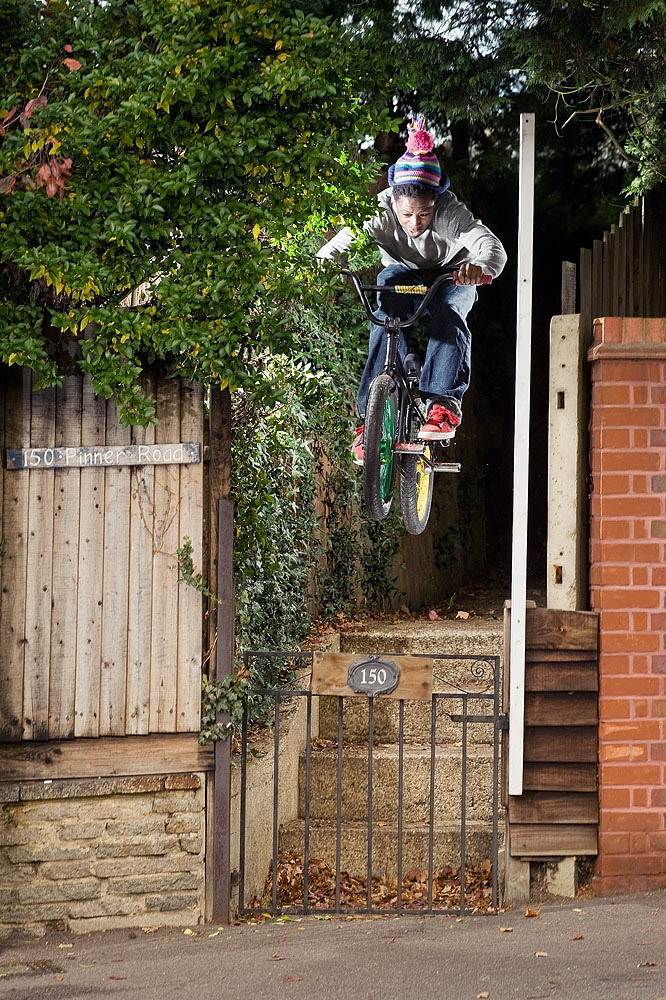
Gate gap
Another unused one from Akin's informer in Ride UK issue 136. Akin had been eyeing this gap up for a while—the path down to it leads through his garden.
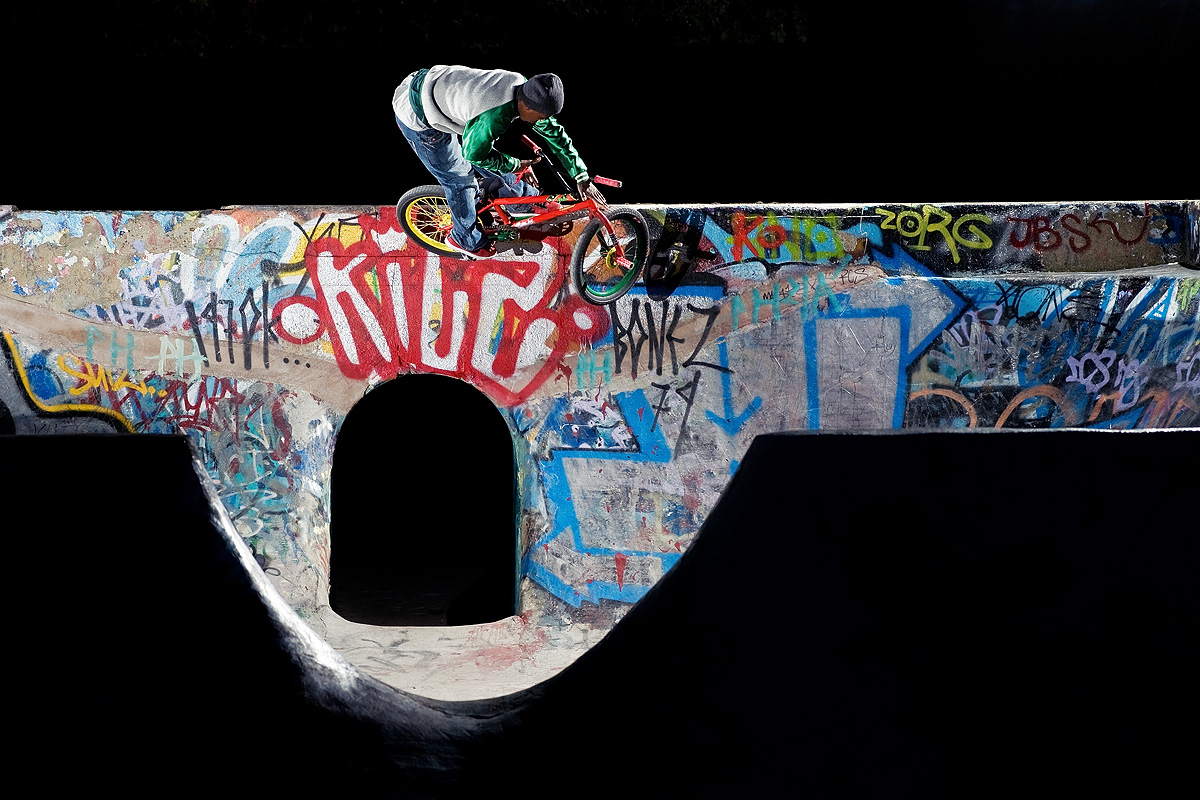
Over the portcullis 2
Akin Hercules-Walker barspin London The Spot
Part 1, from 2007. Published in Ride UK issue 136.
Like his riding and like his bike, Akin is sketchy, slightly wild, loosely defined, still under development. More than once he answers a riding-related question with “when I was living in London…” The distinction is so clear it’s as if he’s talking about someone else entirely, someone divorced from him not only by time but also by distance, buried under years and miles. Anyone at 15 is quite different from themselves at 13, is quite different from themselves at 18—the problems of who you are, who you were, and who you will be are the crux of the teenage years. But understanding his relationship with riding has helped him understand his relationship with who he was, and who he has now become. In terms of the basic mechanics, the hands-on-grips, feet-on-pedals physicality of it, BMX doesn’t really change. It’s a constant, a grid reference. That his relationship with it has grown stronger since the move is no coincidence; the rest of his life is something he’s still mapping out. As for who he will be, I only know that he’s not finished with BMX for the foreseeable future, and nor is it finished with him.
* * *
Subsequent to the publication of this article Akin got hooked up by Superstar through Zeal. You might also like Craig Tull’s Akin edit.
—
Originally published in Ride UK BMX Magazine issue 124, January 2009, the interview issue.
December 2nd, 8.30am, Bristol. I wake up on the floor of room 109 of the Holiday Inn Express hotel. I’m not on holiday, nor am I in a particular hurry. I find my shoes amongst a pile of bikes and head downstairs to the breakfast room to see what they have to offer, knowing I won’t get back to sleep. A TV on the wall projects financial misery and distant disaster onto a spread of glutenous pastries and cups of grey tea, interspersed with a freezing cold weather forecast for the rest of the day. I sit facing the windows instead. Across the road from the hotel is Bristol’s main train station, with a steady stream of commuters emanating from it. There are a few people still here, mostly necking coffee and doing last-minute massaging of some Powerpoint slides. For most people BMX is an escape from the working week; from the path of least resistance. For one Harry Main, still asleep upstairs, BMX is the day job.
* * *
People who go massive have something on other people…Two nights previous, and I’m taking a phone call asking if I want to travel from London to shoot an interview. One night previous and I turn up at Motion skatepark to meet Harry, for only the second time. He wanted to ride the new set up and thought it might be a good opportunity to get some pictures. Tom was kind enough to keep the park open after-hours for us to get the photos we needed.
We go back to the hotel and talk over a laptop and some food from the 24-hour garage. I’m keen to get a sense of how Harry’s life has been changed by BMX. Until the age of fifteen the furthest he’d been from his hometown of Liverpool was Wales:
I had to get a passport to go to the BMX masters … this year alone I’ve used my passport fifteen times or so. It’s so sick to think that before I rode BMX I hadn’t even stayed in a hotel, I’d always stayed in caravans, taking trips to Haven and Butlins.
It quickly becomes evident that travel is a big theme for Harry:
If I didn’t ride BMX I’d never ever be traveling like I do. You’ve only got one life and you’ve got to see the world. I can advise anybody, whether you’re sponsored or not, if you get any spare cash, you need to get to other countries. It’s such a buzz when you arrive in a place that you’ve never been to … The best place I’ve been is Barcelona for the Spanish bike show, I love how ghetto La Rambla is at 2am with the pikeys and prostitutes, with no-one else I know apart from my friends. I can’t really explain it, I just love the feeling of being away, all the new experiences … Whenever I get the opportunity I’ll leave my bike in as much as I’ll take it out and look at the qualities of the place because I’ll probably never see it again.
It’s easy to forget that he’s still relatively young. Eighteen years to his name, and only six of those have been spent riding BMX. We talk about where he started:
At first it was really was just a mess about thing, it didn’t really register that it was something I’d carry on doing … My first bike was a Universal Rabid Storm. It was chrome. I remember the first day I got it I pulled the front brake and the cable snapped, I started crying cos I didn’t know what had happened and thought the bike was broken.
Despite this experience, Harry thinks that kids today care too much about how dialled their bikes are, that they think they can’t progress without the best setup:
I rode a bike with a flat headtube, I’m talking right angles on either side. I used to flip a double coping spine, jump over the handlebars and run down the landing when I was trying to learn … A week after that I was on the flairs.
Likewise he doesn’t think that a less-than-privilidged background has to preclude someone from their aspirations:
I came from nothing—my family haven’t got a lot of money. I’m not saying we’re poor, but I’ve always worked for it. I used to do the dishes in my house … deliver 48 papers a night … just for that money for a session on a Sunday … I did shelf stacking in Iceland. My boss knew I was getting somewhere with my riding so he’d always do anything he could to help out, getting people to cover if I had a contest or a photoshoot. He always used to joke, asking if I’d met Dave Mirra, because he’d seen the game. I met Mirra at FISE just before I finished at Iceland and my boss couldn’t believe it. It’s funny to think that BMX got that big really.
Contests are one of the main reasons that Harry is able to live the life he now does. NASS 2008 was where I first saw him ride in person and in the UK at least, he is probably best known as being a contest rider. I ask if this is a fair assessment.
I like to try to stay at a competitive level, it keeps the fun in riding for me. If I wasn’t progressing then I wouldn’t get the buzz I get out of it. I’ve got to keep learning to keep it exciting … It’s so good when you get to the end of a run and you’ve just done exactly what you wanted to do and everything’s worked out.
He’s keen to stress that attending all the contests isn’t something his sponsors put on him:
I personally want to go to all the contests so it happens to work out better for both of us. But you’ve got Dave Rytell and Nigel Sylvester on the [Mirraco] team and they don’t really do contests.
Harry’s aim for next year is to spend more time in America and ride every park stop on the Dew Tour, arguably the biggest contest around.
Personally I think without the Dew Tour BMX would die, even though people hate it—say they hate it—I don’t think BMX would be what BMX is without it.
Throughout the evening I’m impressed by how well-versed Harry is when it comes to BMX. He seems to know who everyone is, who did what in which video part, whose magazine interviews and covers he liked and why. We talk about a hot topic of the day, the Nike web video and certain comparisons that have been made:
I’d prefer to watch Garrett Reynolds than Van Homan. The stuff that Garrett Reynolds is doing now—there’s new school and then there’s him.
And other riding inspirations:
I used to see my local heroes like Jon Taylor, Alistair Whitton and Owain Clegg, they’re the people I looked up to when I first started, it’s because of people like that I got so into it. One of my main riding inspirations is Ben Hennon … that’s the best style of riding, pedalling at anything, same as Dave Mirra and Jamie Bestwick, they go massive on everything. People who go massive have something on other people: plenty of people can do any kind of backflip variation but not a lot of people can go higher than everyone else.
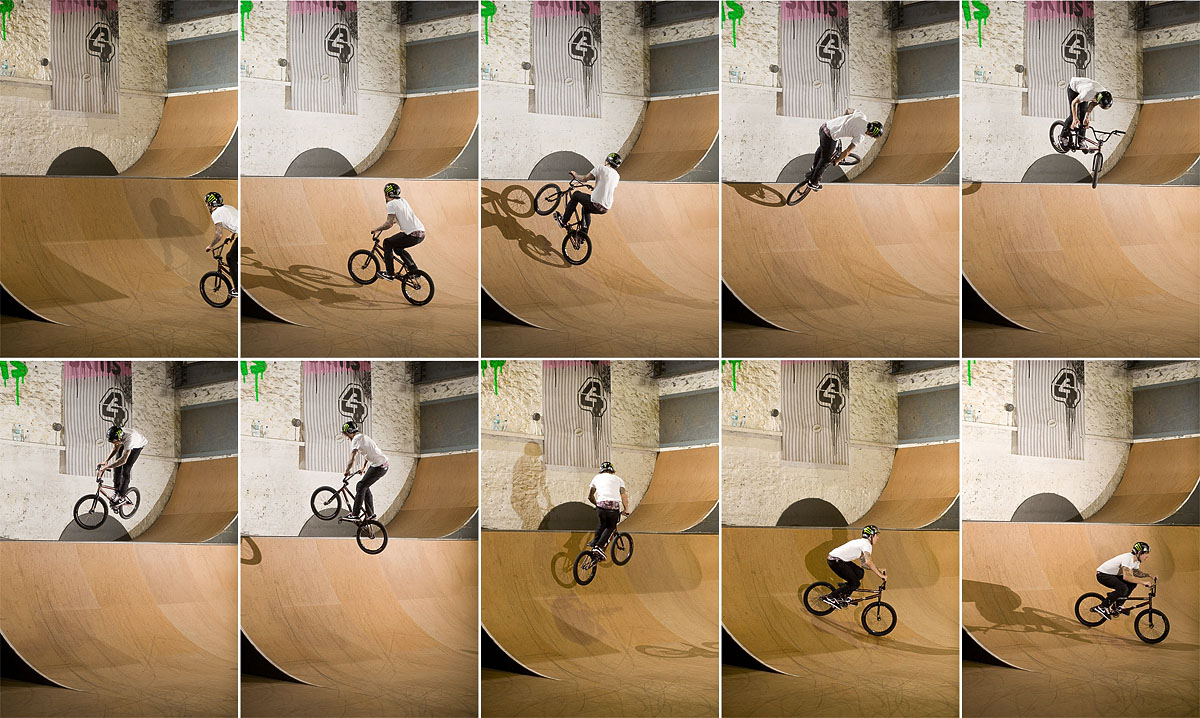
Sequential
Harry Main 540 barspin Motion Ramp Park
Shot for the interview but published as an @random on Defgrip.
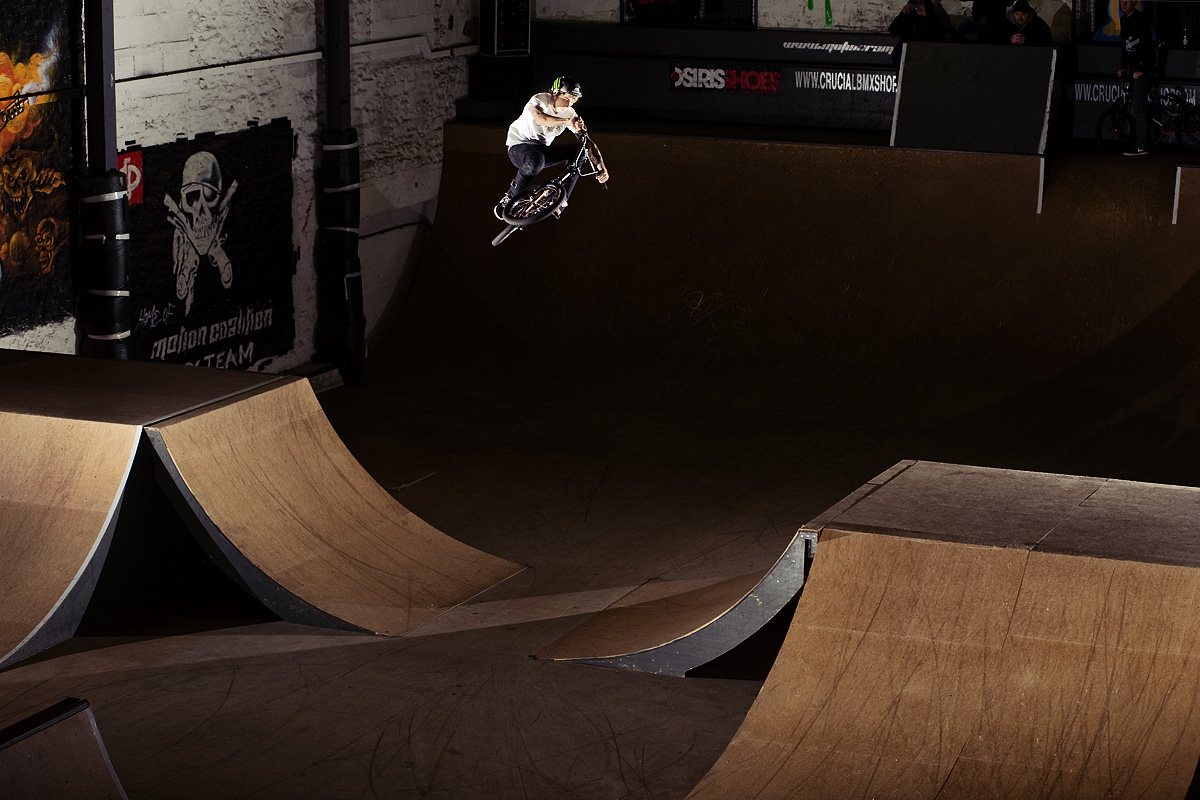
Box to box
The wildest thing about this gap is that it wasn't pulled first time. Published in Ride UK BMX Magazine issue 124.
* * *
Back in the breakfast room the 24 hour news channel has been turned off, replaced with a CD of Christmas music. A suggestion I’ve outstayed my welcome perhaps. It’s 10am and time to wake Harry and his friend Craig. We’re riding street today, our guide is a Bristol local called Lucian who Harry met for the first time the night before. Despite how hastily arranged the trip is, I’m impressed with the initiative Harry’s taken. He mentioned that he was keen to show people that he could ride street. To my mind it’s more about showing himself that he can ride street.
To a certain extent there’s a contradiction between how much Harry cares about how he’s perceived (he refers a number of times to “the negative side of BMX”) and how little he professes to; “any publicity is good publicity” he quips. If anything it’s a contradiction that arises from his overwhelmingly positive attitude: On one hand he wants to dispel negativity, but to react is to become a part of it:
It pisses me off when people tell me to get off the ramps and call me a ramp rat so I wouldn’t inflict that on a street rider who doesn’t feel in the mood to ride a quarter.
Even more so than contests, Harry’s lifestyle is enabled by his sponsors. If there is bigger money in BMX these days you can hardly begrudge him getting some of it. I ask if he had any reservations when he was offered to ride for Nike, considering some of the negative sentiment that exists towards their being involved with BMX.
If people want to call me a sell out for riding the best shoes out there for BMX, with the best style, the best quality and the best technology then I guess I’m a sell out aren’t I?
He likewise has no qualms about Mirraco being owned by Trek. Later on he admits that Nike paid for training on how to interview, which covered questions like that. The answer is a little canned, but the conviction behind it rings true. I can think of few people I’ve met with Harry’s dedication (BMX is self-admittedly the only thing he finds interesting) and realistically Nike are one of the few companies with a budget to allow him to apply that dedication in the direction he wants. Not to say that he’s unrealistic about it lasting forever:
You might be doing it one day and getting paid and you might not the next day. If my contests stopped and my sponsorship stopped I’d probably be on the dole riding a bike every single day.
We wheel the bikes outside and put foot to pedal. After meeting our guide and hitting the first few spots of the day we head to Crucial, the local BMX shop. Harry’s back wheel needs attention from some flairs that didn’t quite go all the way around. Lucian mentions that the shop’s got one of his signature bikes from his previous and first sponsor, KHE. Harry is curious, not even having seen the bike before leaving the team. Ironically when we get there it’s also departed—sold the day before.
Being with KHE was amazing and I want to thank them for where they helped me to go, but it felt like I got to a point where I couldn’t grow any bigger than I was. With Mirraco I feel like I’ve got more opportunities, more places I can go. it’s exactly where I want to be.
It was literally either sit in school with my head in a book or go out riding.Harry’s other sponsors are Monster Energy Drink and King Kong pads. He’s keen to give them their due, all part of how consummately he runs his riding career. Throughout the day he’s taking calls from sponsors, arranging schedules and discussing prototypes. It’s always been something he’s managed himself (out of choice rather than any unwillingness on the part of his parents) to the point where he is earning a living off riding. That he left school aged fifteen without a GCSE to his name goes some way toward explaining how he got there so young:
When people hear about this, and I’ve seen it on forums, they think I left school to turn pro; it wasn’t like that. It was literally either sit in school with my head in a book or go out riding. To me, being out riding was a lot more interesting, so I just thought fuck it. It wasn’t a calculated risk, I didn’t think I’d ever get to this level. You never know what’s round the corner in life so I don’t see the point in waiting round in a school … I didn’t get expelled or suspended or anything, I just stopped going—don’t get me wrong, my mum and dad were so pissed off. It got to the point where we were arguing so much that we could either fall out or I could do my own thing and they’d respect it. It was my final decision.
To think Harry was stupid would be stupid in itself, evinced both by how adeptly he manages his riding and the considered manner in which he answers my questions.
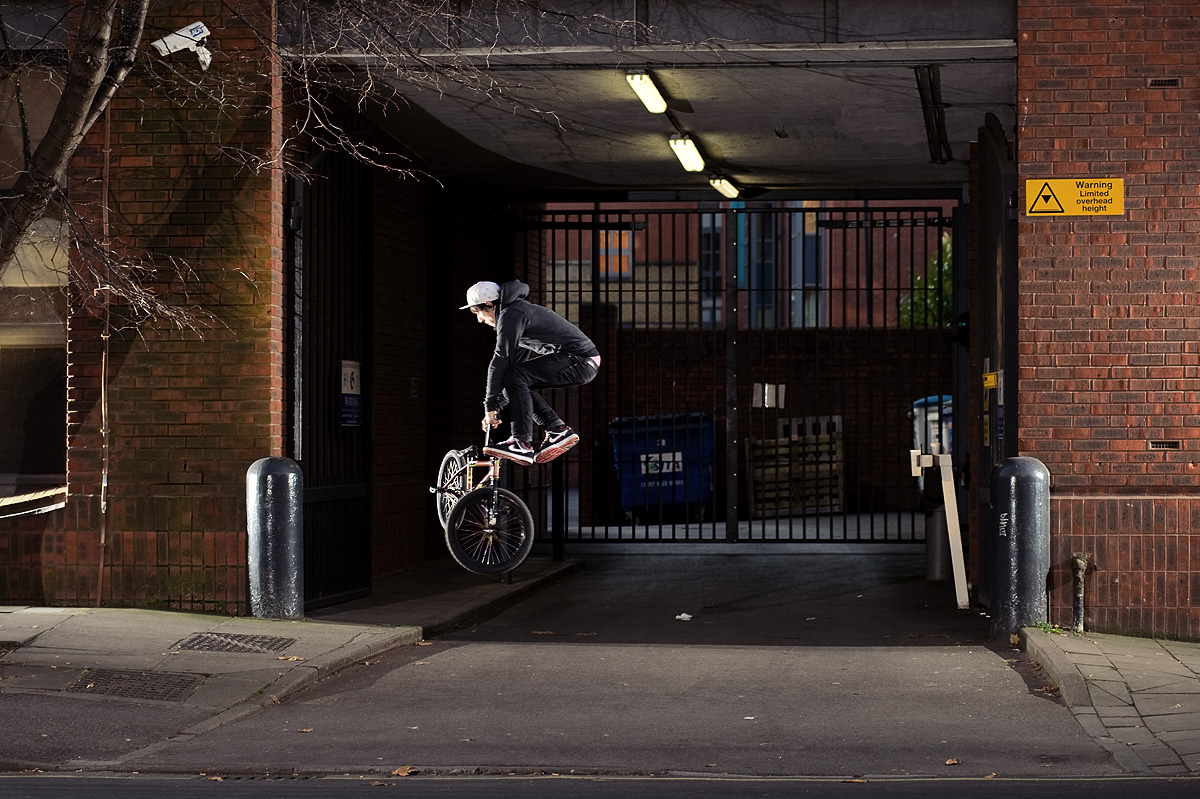
Road gap
The police turned up as soon as I'd finished setting up photo. We somehow convinced them to let him have one go at it. Published in Ride UK BMX Magazine issue 124.

Last trick
I'm not going to post every photo from the article here, but I thought it would be nice to see this one uncropped. Published in Ride UK BMX Magazine issue 124.
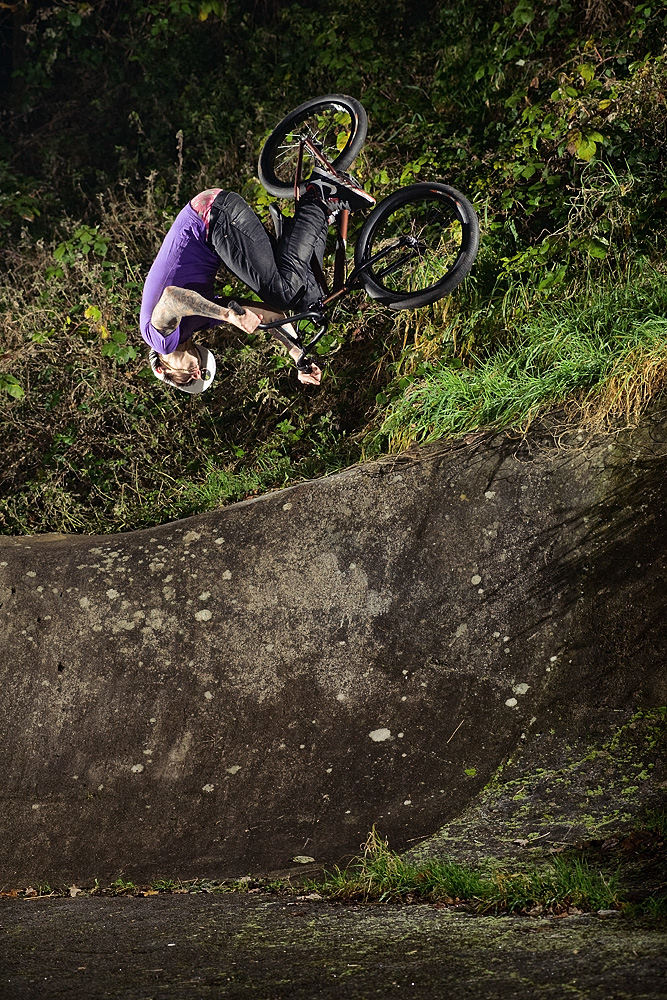
Cover
If you look closely you can see how the bottom half of the transition is slippery with dew. Published on the cover of Ride UK BMX Magazine issue 124.
All in, we ride around the city for about nine hours, with the temperature not venturing far above zero. As with the previous day Harry falls from some unenviable positions but seems unaffected. About 7pm we stop back at the hotel to warm back up and order some food. Nike can’t have many athletes with Harry’s diet:
I eat pizza, that is it, flat out. When I’m in The States I eat hamburgers cos they make the best hamburgers … no, my mum makes the best hamburgers, make sure you put that in.
We head back into the street to shoot one more photo. That done, we return to Motion where Harry remains on his bike, unable to resist getting more riding in. After I while I leave to catch a train, back to London and the day job. Harry is staying one more night and then to who knows where, Greenville USA, maybe. I ask if he feels lucky to be living the life he does: “I used to knock on wood for luck”, he explains, “my mum slapped my hand and said ‘listen to me: you make your own luck in this life'”.
—
This was the first full-length article I wrote for Ride UK. Originally published in issue 118, October 2008, written around June 2008.
Nan Goldin maintains the only people you really have the right to photograph are your own tribe. And my tribe for the last four years has become a group of BMX riders in and around the UK’s largest town, Reading. Before I came here for university I’d already been riding for about four years and now I’m graduating and moving on.
…BMX also exists in the most ordinary places, and it doesn’t get much more ordinary than Reading.What’s really great about BMX is that it exists wherever you go, from the polished glass and chipped marble of a financial centre, spade-sculpted woods away in the countryside or to the Favelas of Rio-de-Janerio (see Bruce Crisman’s video about Alessandro Lima Terres). But it also exists in the most ordinary of places, and it doesn’t get much more ordinary than Reading. From the moderately successful football team that people get immoderately fervent about, to drowning the week in vodka mixed with unfamiliar brands of energy drink. Points on your license and another strappy top from H&M. “Sluts” and DIY. The M4 motorway snakes around it, railway lines fan out towards London, the major cities of the North, South and West, and other parts of the commuter belt. The town drains into waterways which once trafficked people and things. It’s somewhere you pass through on the way to someplace else—Reading is a hundred and forty thousand people who missed their connecting train.
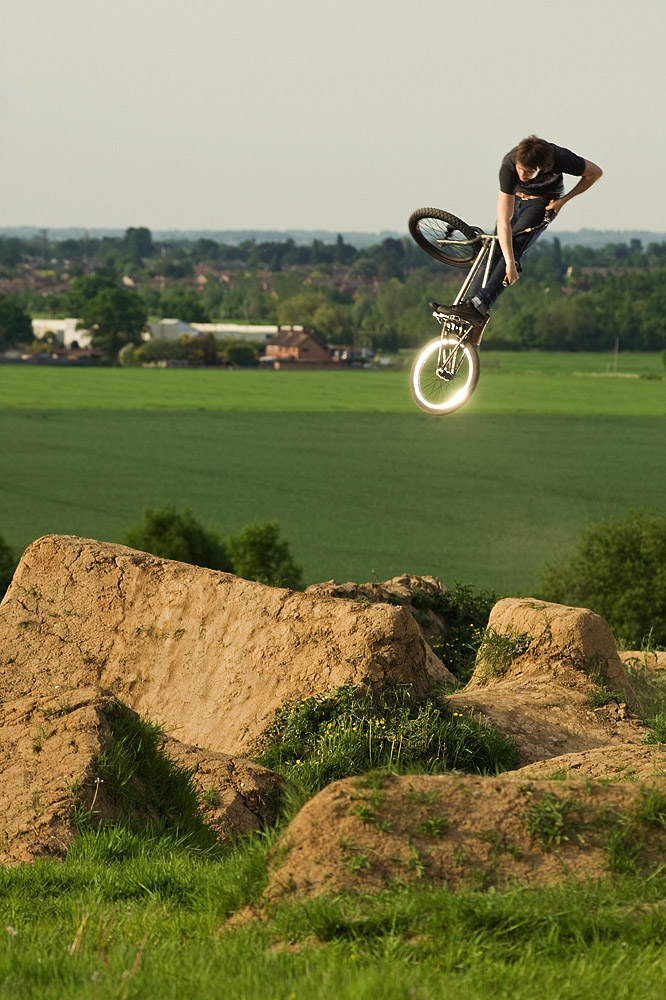
catching the sun
Scott Sharp turndown Reading The Field
from the Reading scene report in Ride issue 118.
It’s rarely the grim, honest hardship romanticised in Arctic Monkey’s songs and episodes of Shameless; only a home-counties poverty of aspiration instead. The only people I’ve met here who it hasn’t completely ruined have been the ones who ride. BMX is doing something with your life, but not in a context that people who don’t ride can hope to understand it. A meaningful act within BMX is what you define it as, and, by extension, what your tribe defines it as. It’s not the one-way diktat of society at large; maintaining a dysfunctional relationship, school, choosing the right car or celebrating three-one. Such achievements aren’t so pressing if BMX is a more interesting fiction, and sometimes it requires the tribe to unwittingly nourish that conviction.
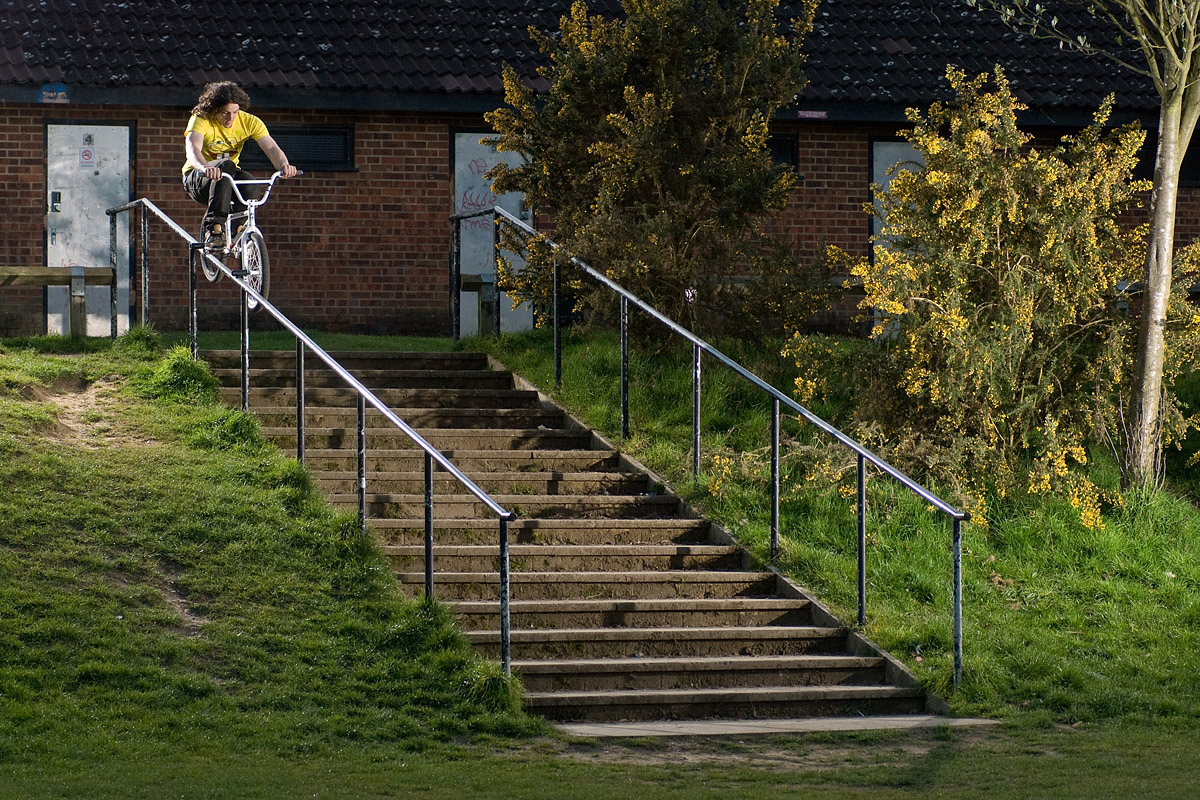
menthols and spongebob
from the Reading scene report in Ride issue 118. Like some of my better photos, this is also available on Flickr.
Whether you’re exploring your surroundings as part of growing up or, like me, as a migrant, a bike—any kind of bike—is a pretty good vehicle. You’re not boxed in like a driver, but you can get around a lot faster than by walking. Whatever impression you form of a place defines who you are as much as any interpersonal relationship does. Whatever impression you form is going to be subjective based on your interactions with the place, but it’s less misinformed if you take in the ordinary as well as the noteworthy. Because riding BMX enforces a different engagement with your surroundings you see the dull parts of a place no-one else bothers with. And because BMX gives you this unique engagement with your surroundings it’s a way of exerting your identity back upon a place. There’s nowhere more important for that to happen than somewhere as dehumanisingly ordinary as Reading.
In the film Happiness there’s a scene where one of the characters is talking about the place she lives:
Y’know, people are always putting New Jersey down. None of my friends can believe I live here. But that’s because they don’t get it: I’m living in a state of irony.
As a satellite to somewhere ostensibly more exciting, Reading has some parallels with Newark, New Jersey, where the film is set. But irony admits defeat: It’s better to engage with what you’ve got, which is why there’s a good scene here, even if it’s not somewhere many people travel to as BMX tourists.
We have an assortment of small outdoor council skateparks, which run the gamut from fun to shameful wastes of tens of thousands of pounds. The council also provide a racetrack, but like many of the skateparks it’s in one of the worst parts of town (so read run-down, littered with broken glass or no place to go alone). Somewhat better outdoor parks can be found in nearby towns like Farnborough, Bracknell and Maidenhead, along with the similar scenes that form around them. There aren’t any indoor parks within an hour’s drive, but various people have been trying to get one running since before I came here and it looks their efforts might pay off sometime in the not so distant future.
Most of the street spots look better than they ride, but there’s enough variety to keep life spiced. The town is sufficiently sprawling to find new things to ride every once in a while, and occasionally a new construction brings a new spot with it. Having lots of large office buildings and a university helps (although both are conscious of BMX and skateboarding so there’s no shortage of skatestoppers and jobsworthy security guards). Most importantly there are enough people who are willing to spend a few hours after work hitting up spots, or taking a pedal to scout out somewhere promising.
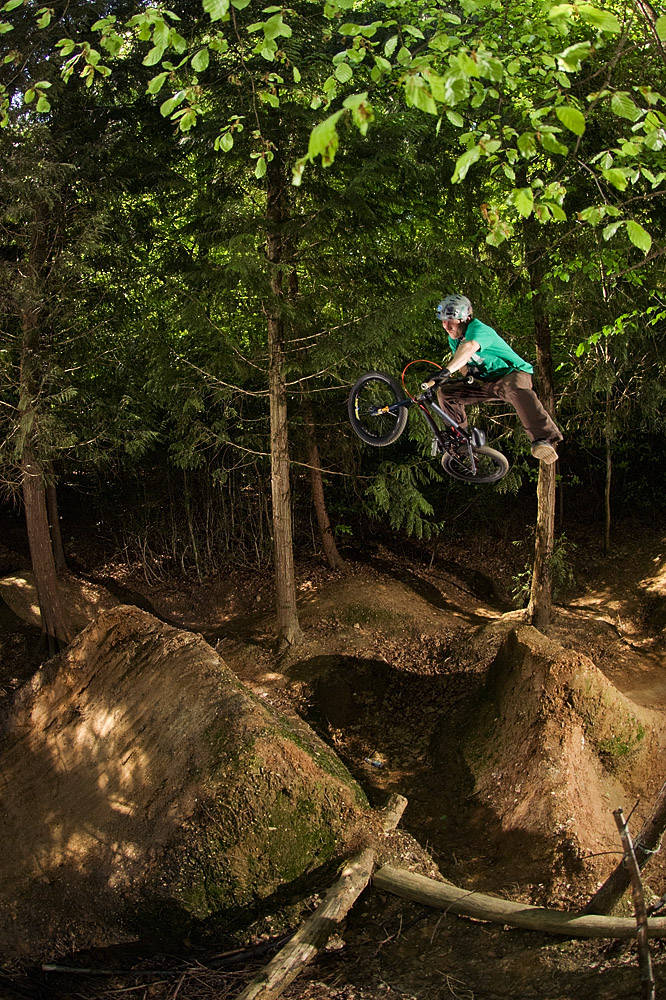
channeling taj
jim one footer table Reading Shitty B's
unused photo from the Reading scene report article.
Trails come and go; Knowlhill, for example, got knocked down soon after I moved here. But there are always people digging, and when summer comes around there’s always something running. We’re now lucky enough to have people nearby who rent land or have built stuff in their gardens, so something more permanent is available, for the moment at least. Even if there’s no riding happening, a trip to the trails is always a good excuse to eat barbequed food and hang out in the woods with friends.
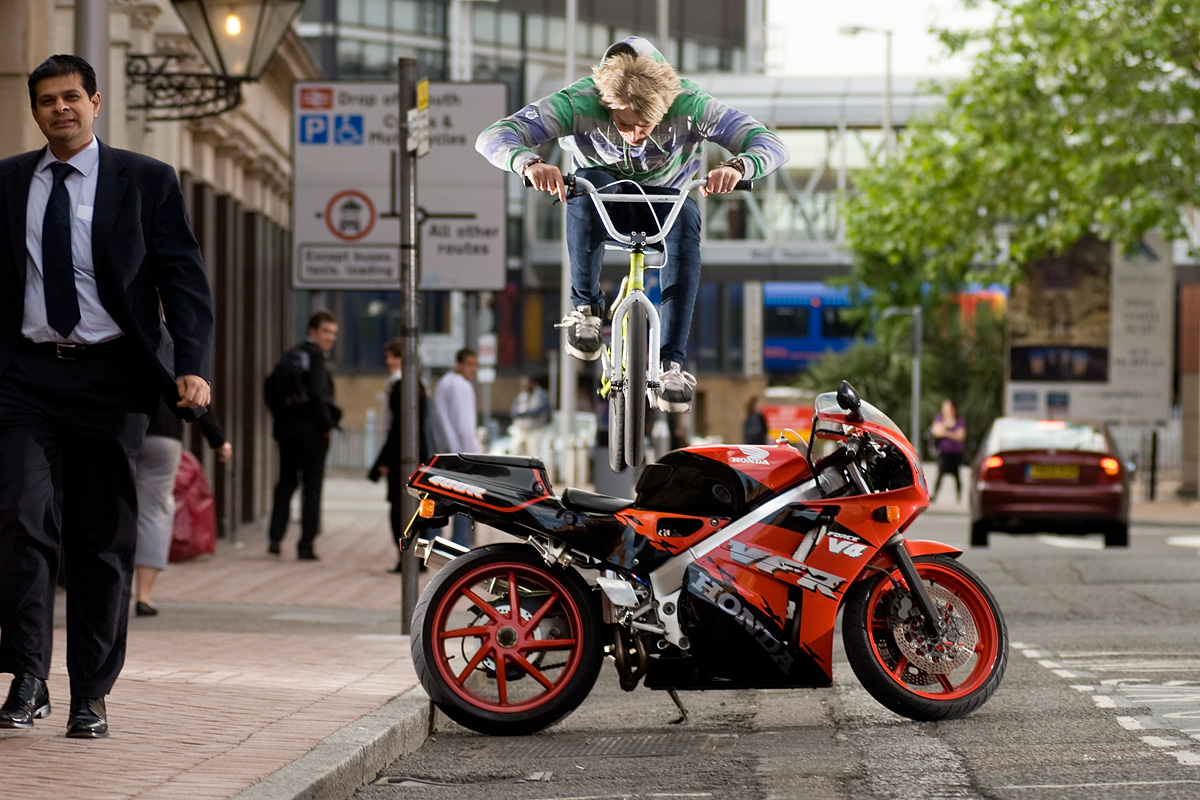
whitey, you wont hop a motorbike
Ride UK BMX Magazine issue 118 is now out, featuring a Reading scene report by me. Here's one photo from it, go purchase to see the rest.
So this article isn’t as much a goodbye to Reading as it is a thank you to the only people who could have made it feel like home, the people who have written me into the collective fiction we tell each other to make sense of this place. I’m not sure what story I’d be telling myself (and recounting to you) if it wasn’t for this lot so the least I can do is get their names printed in a magazine: Here’s to Adam K, Babs, Bateman, Bowen, Brash, Cameron, Dan, Dias, Fat Sam, Flatland James, Gary Gurner, George, Greg, Guy, Jim, Joe, Josh, Konstant, Kurt, John Wells, Leon, Little John, Matty, Max, Merlin, Nate, Paton, PullBackAndYank.com Sam, Peeling, Polski Mateusz, Reece, Ricky, Roland, Ryan, Sam S, Sharpie, Shitbag, Sick Ant, Sid, Sketcher Kris and Whitey.
—
About eight years ago, a Cheltenham local made a pilgrimage to Livingston skatepark. I was sixteen, he was a postman and used to unorthodox hours. He drove the 350 miles, slept overnight in the car, rode out the AM, and then returned—a loop stretched flat as an elastic band round a single envelope. His trip was interpreted as an Alan Partridge-esque, barefoot, Tobelerone-gobbling, private breakdown. People talked about it more than they asked him about it. I recalled it while en route to Livingston myself, in the company of six other Cheltonians (no, really, Cheltonians).
Neither journey was setting a road trip precedent, which is unsurprising given how claustrophobic a little place the UK can be. Column inches of population increases; square miles ceded gradually to the sea. A nation of Top Gear watchers: the mentality that everyone else is out to interfere with your right to do whatever-the-fuck-you-want, viz. spin your car in smokey circles in peace, patronise the life out of any other nationality, or most of all, comatise yourself to a flickering, televisual depiction of televisual characters indulging said rights. A kind of paranoia that perhaps, unchecked, leads to a brief period of feral existence punctuated by the gunning-down of those who you feel are interfering with your right to do whatever-the fuck-you-want. Which well described our trip (with BMX in place of killing anyway—the only shotgunning was of the front seat).
The plan was to be away five days, i.e. four nights spent camping in the wild. The first day was mostly driving, aiming to get somewhere into Scotland. Turning off the motorway into Moffat, we stumbled across a mini ramp, whose unworn paint gave its metal surface the affordances of wood. The unvarnished awe of the gathering teenagers made it obvious that it had never been used in earnest, least of all by them. We left them—sharing their single of bottle of beer—down a road on which they described there being “fuck all till Edinburgh”. By the last light we made a right down another road, narrower, unmarked; its verges bristling at the wheelarches. As the first light crested the horizon somewhere way, way easterly and we crested the road’s final hill, a brutalist concrete structure emerged into view. Seconds later, a vast reservoir expanded out behind it. The final hill turned out to be the embankment of a dam. We explored the shoreline’s eerie silence until we were satisfied it manifested absence and not lurking menace, and along it made camp.
Livingston was day two’s first stop, which met every expectation a 700 mile solo round trip afforded it in the eyes of a sixteen year-old boy. After that was Edinburgh’s new concrete park (Saughton). According to a local it’s not too busy before nine AM, or after eleven PM (though the lights go out at ten, and it’s probably not the kind of place you’d want to be after dark, potential for endless runs or otherwise).
As a consequence of the crowded skatepark we left with plenty of time to get west to Glasgow, then north along Loch Lomond where the road, railway and not much else squeezed into the space between hill and shore. Jutting out from this corridor and into the loch was a small peninsula, out along which we carried ourselves, our tents and Morrissons carrier bags, laden with what seemed like the last vestiges of fluorescent-lit civilisation. Above our campsite rose a hillock verdant with ferns. We gathered branches from the trees which had failed to cling to its steep sides. We gathered driftwood from the beach that looked out onto the rest of the loch. We arranged our tents in a circle, around a circle of stones, and made a fire at its center. The swoop of full-beams confined to the distance. It could not have been more idyllic.
It wasn’t until the third day that our family camping holiday went awry.
The morning started alright, a dip in the loch at least partially washing off the smell of fire. By the time we got to bundling ourselves back into the cars the fine mist rolling down the hillside had coalesced into something more like rain. We made for Unit 23, Dumbarton’s indoor skatepark, whose prime attraction is a voluminous wooden bowl. It’s rare to ride something which has totally alien aspects, whose contours you can’t map onto some previous experience and adjust to accordingly. As indoor skateparks go, it was pretty exciting. After leaving there (and making another trip to the supermarket, because that’s just the kind of primal hunter-gatherers we are) it was getting late to be finding a camp. As it became less and less likely that we were going to settle on a spot the decision got made: leave for home now and be in bed by 2:30AM. And so began our own pilgrimage back down the M6, in the finest tradition, themed by the overconsumption of energy drink—as Partridge with Toblerone—dispatching the spent cans out of the car window like shotgun cartridges. We didn’t reach Cheltenham until 4:30AM.
It was our giving in to the mania of the UK road trip. Accepting it. Allowing it within. Acknowledging that it’s less the fear that people are out to interfere with your desire to do whatever-the-fuck-you-want, but that whatever-the-fuck-you-want won’t be enough. That it won’t be close enough whilst still under the same pebbledash clouds, eating service-station BLTs. Save for these three days in Scotland when we made it enough: held out for as long as that understanding required.
* * *
You might also like to see Jamie's edit of the trip or Luke's photos from the trip.
—
